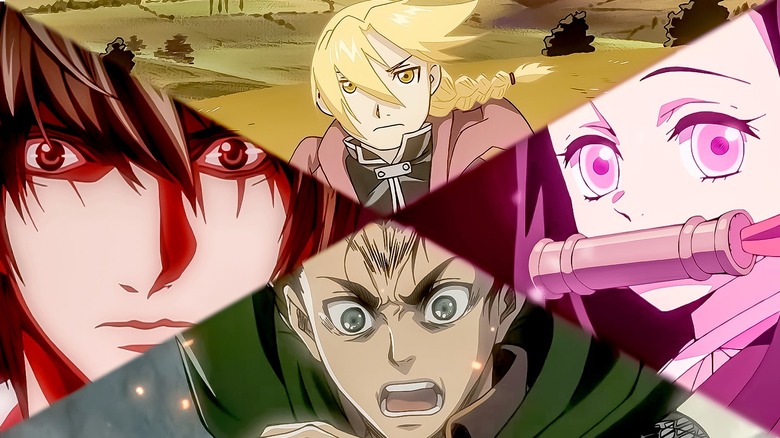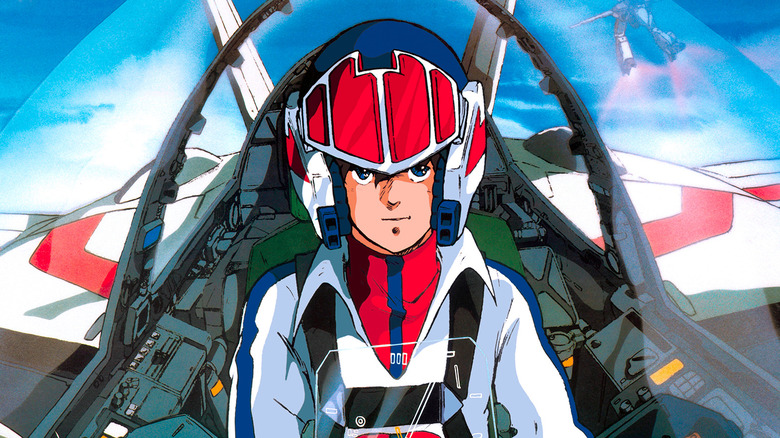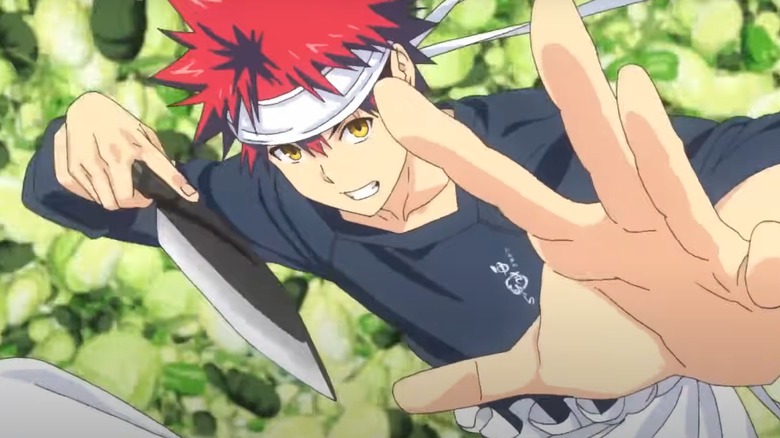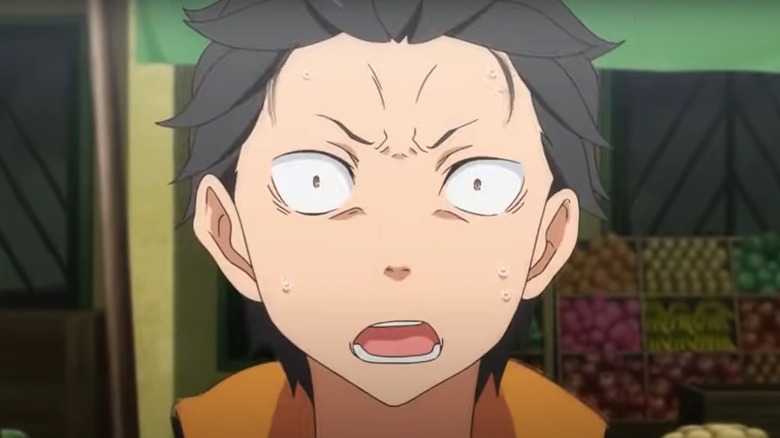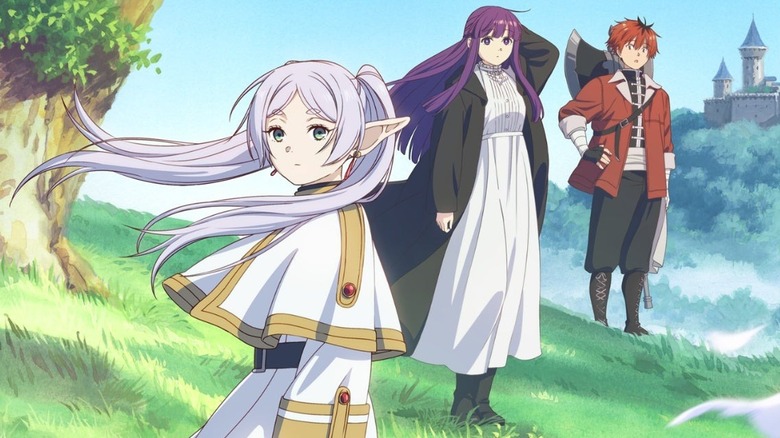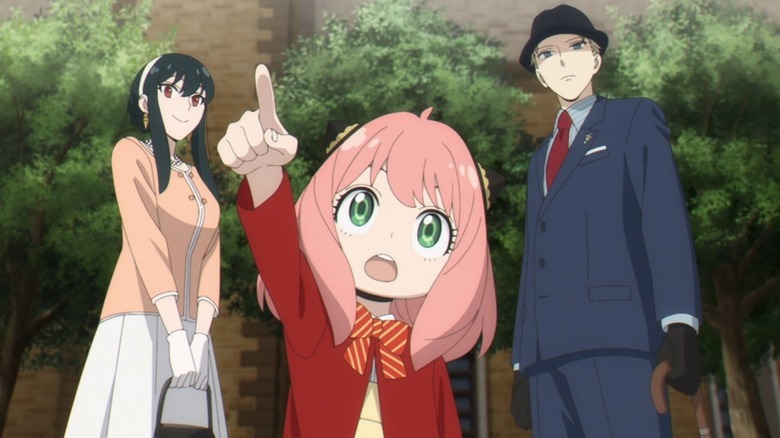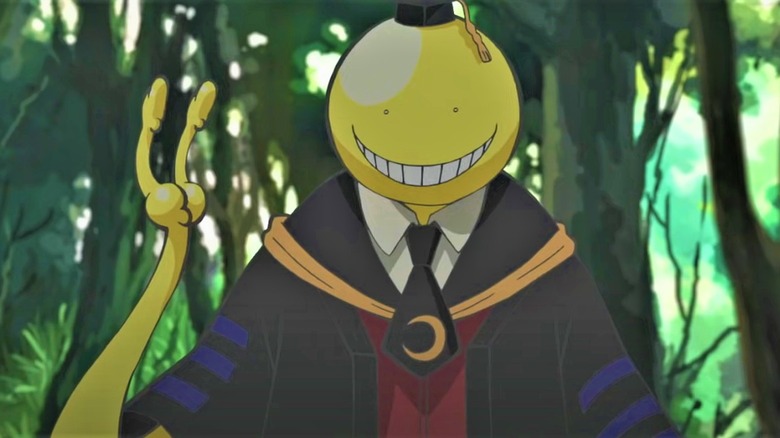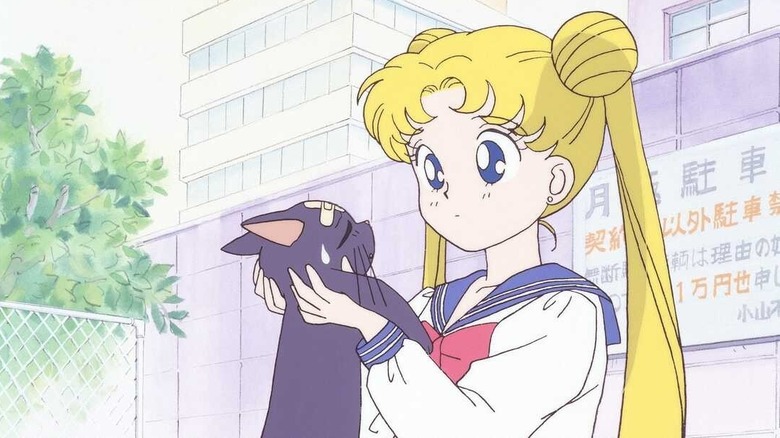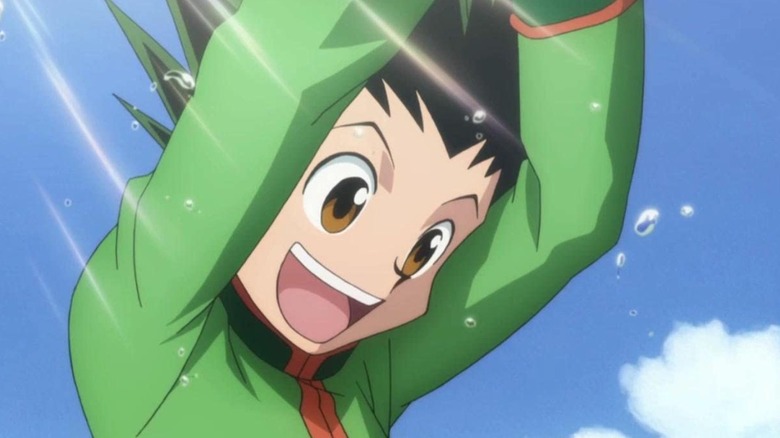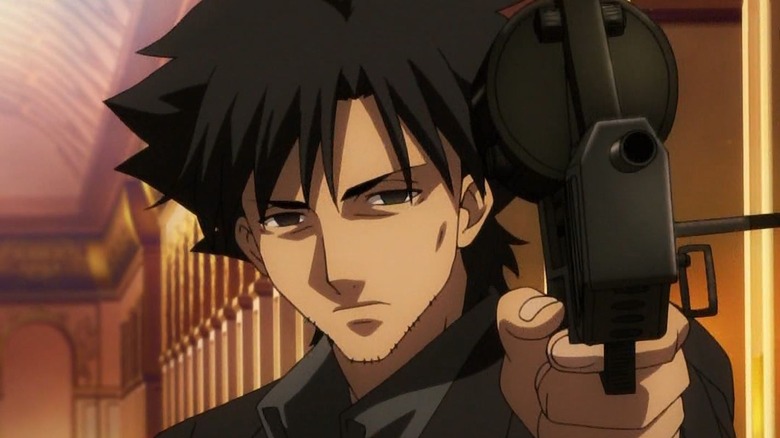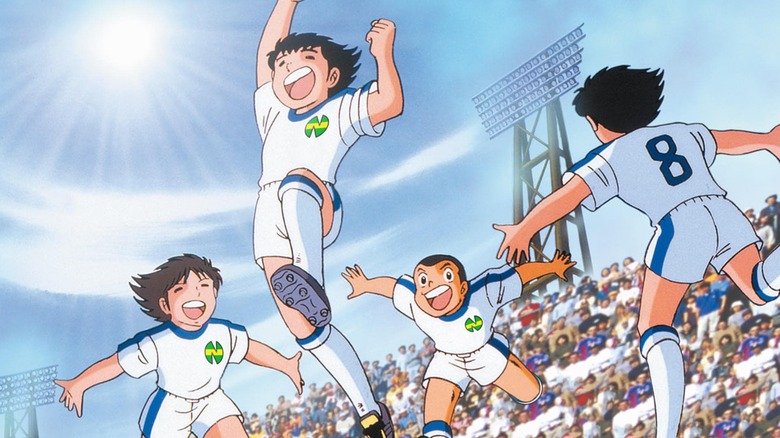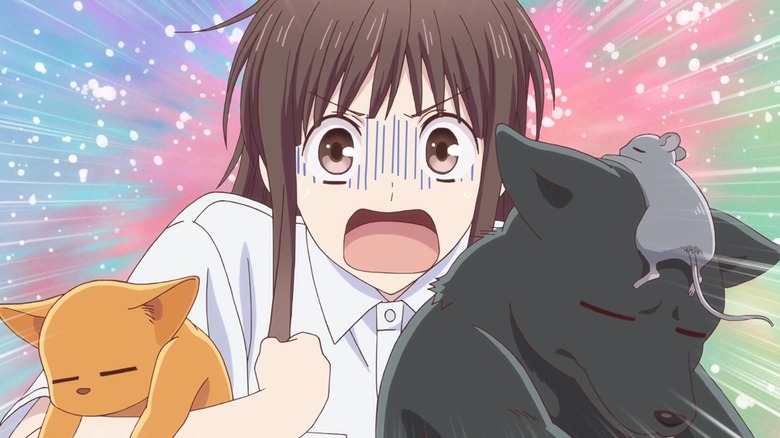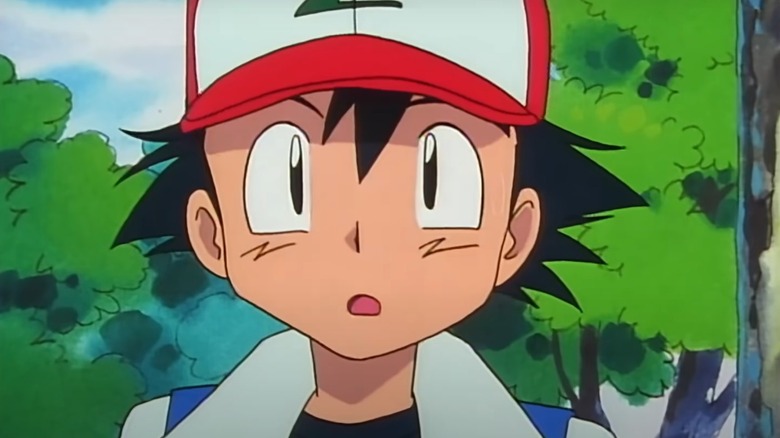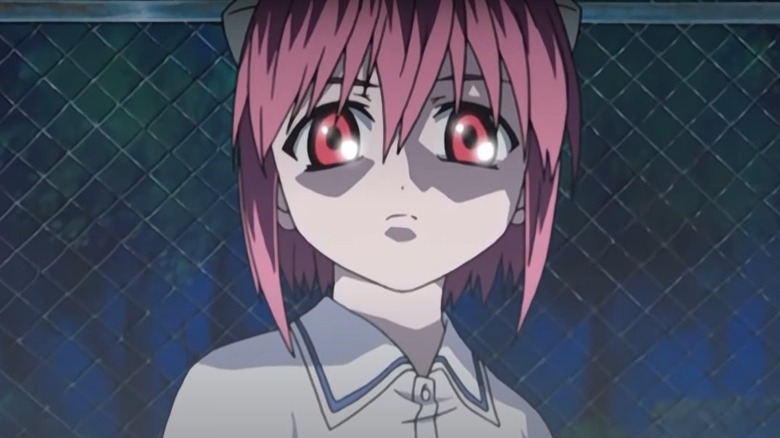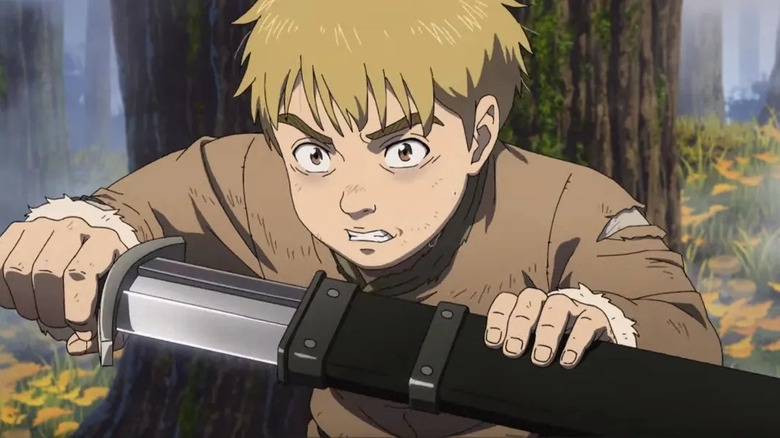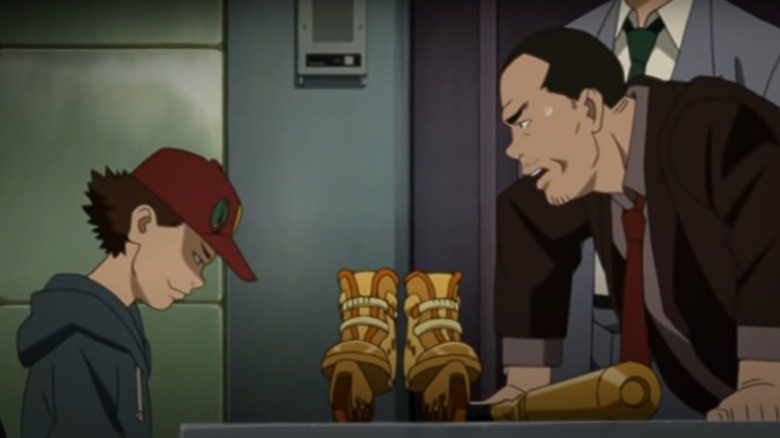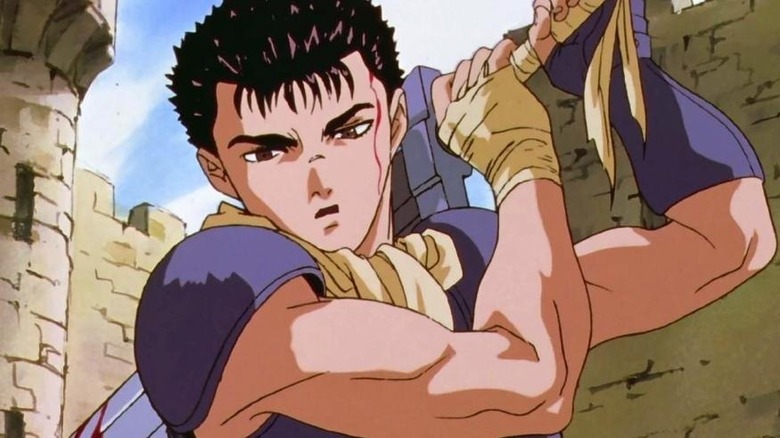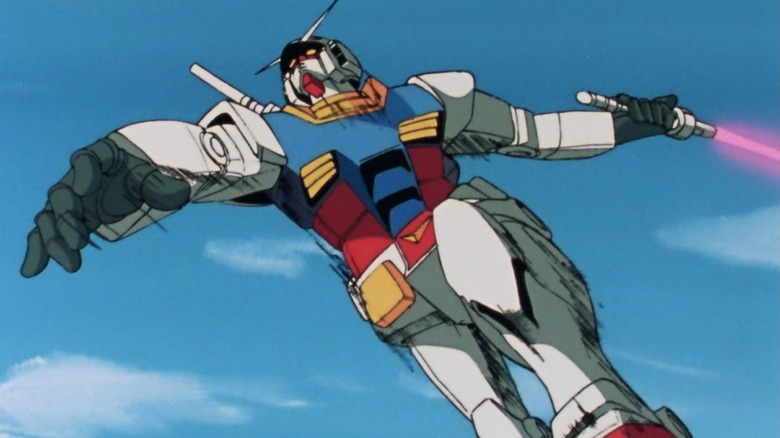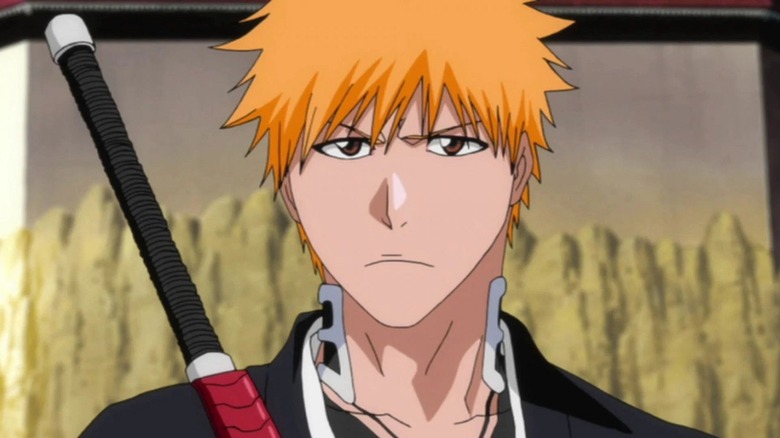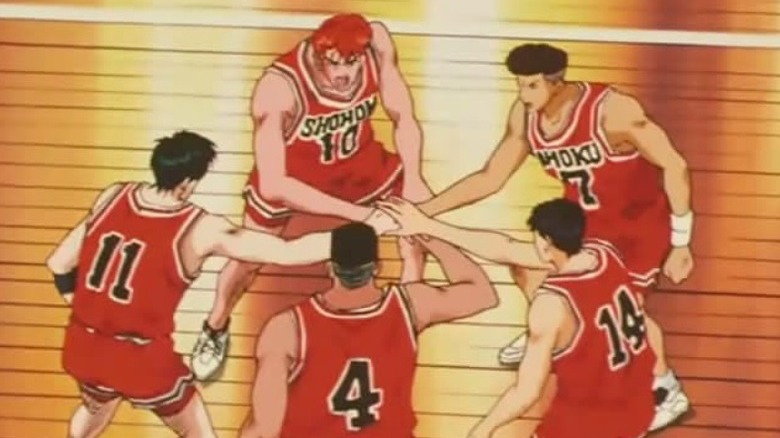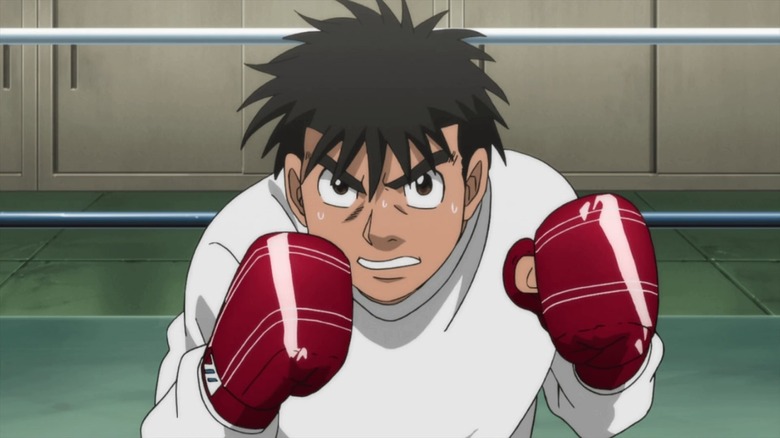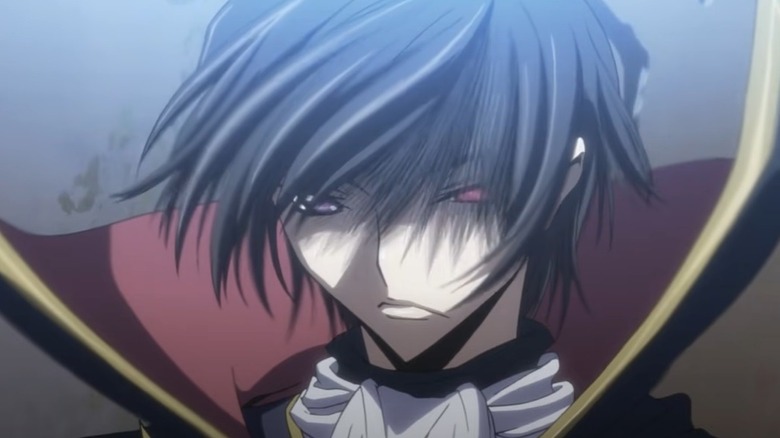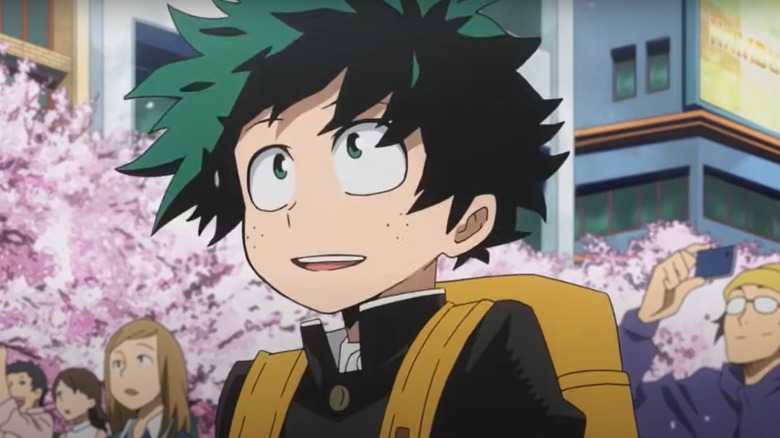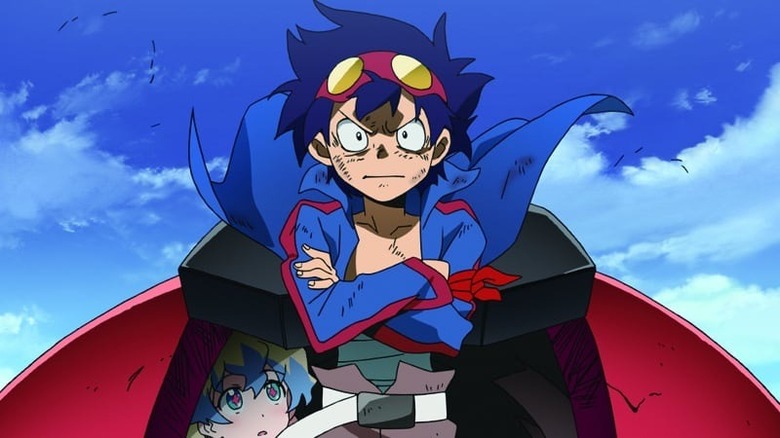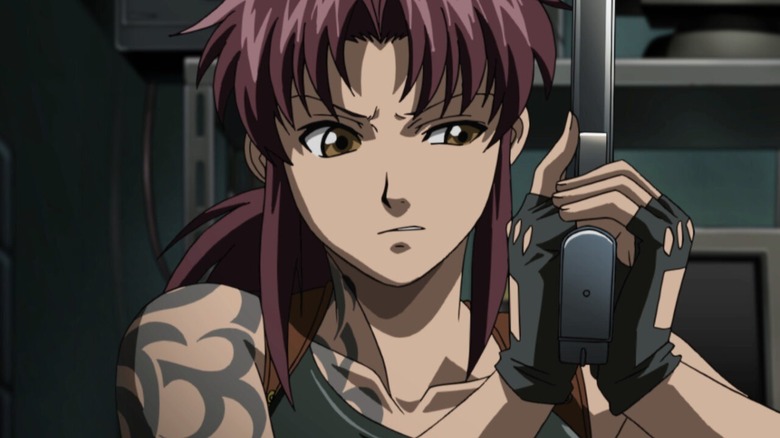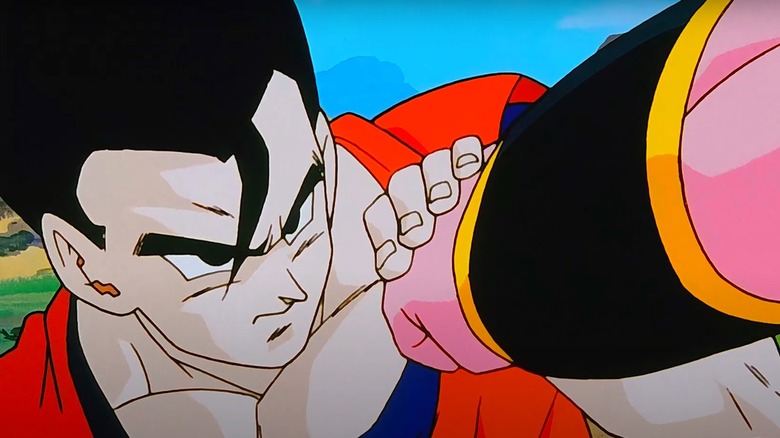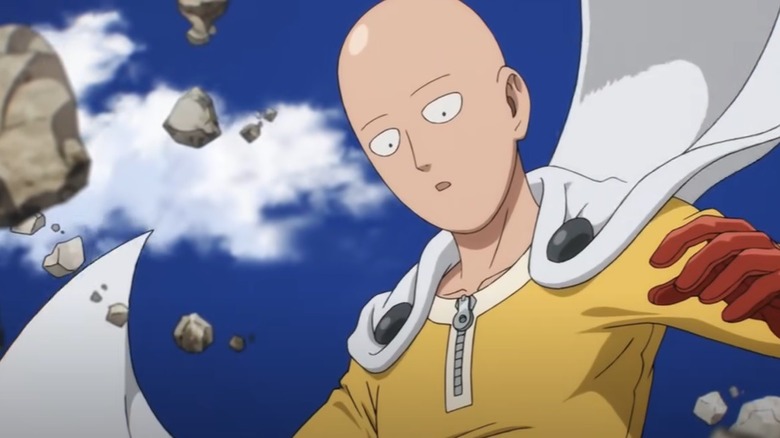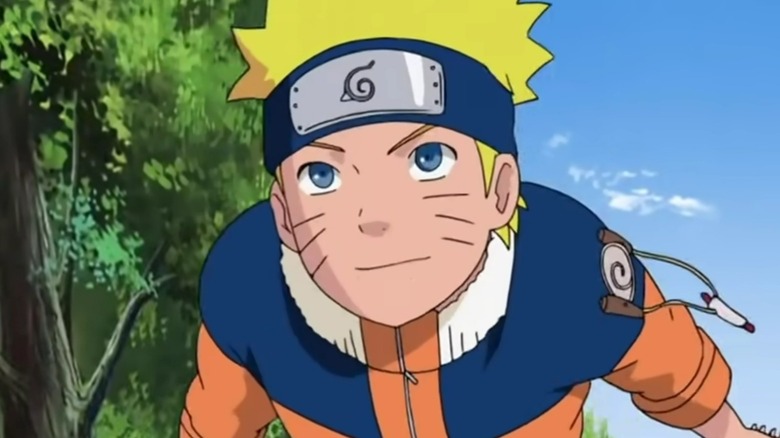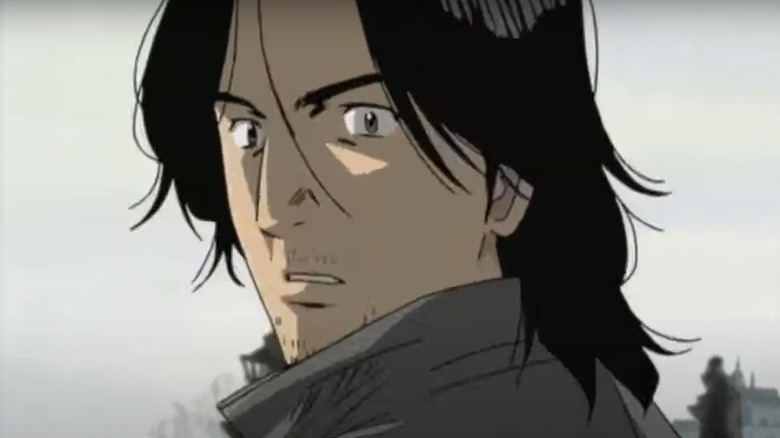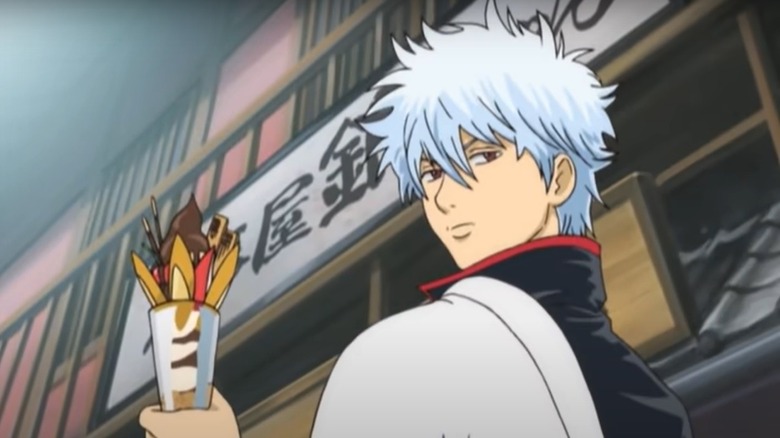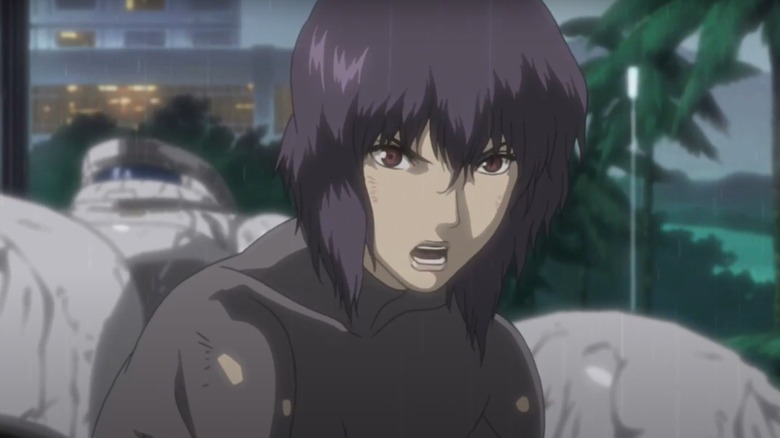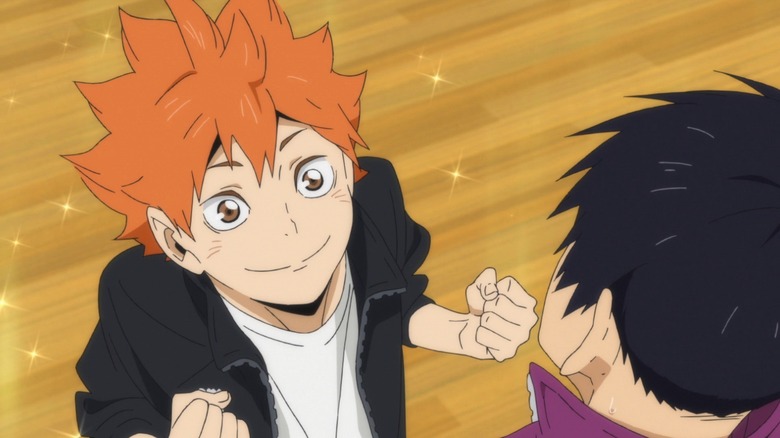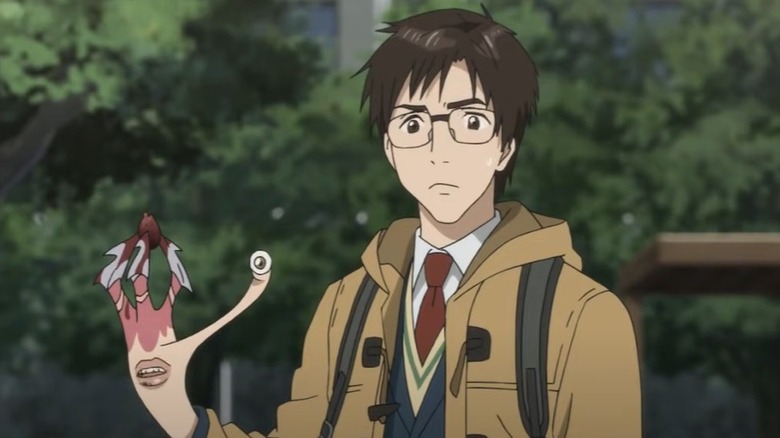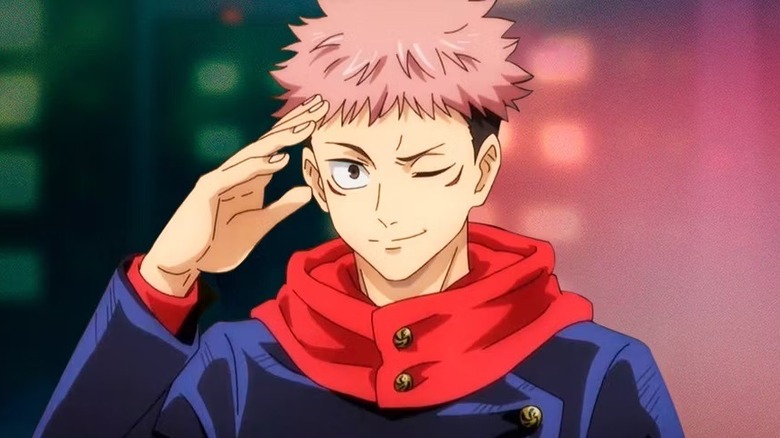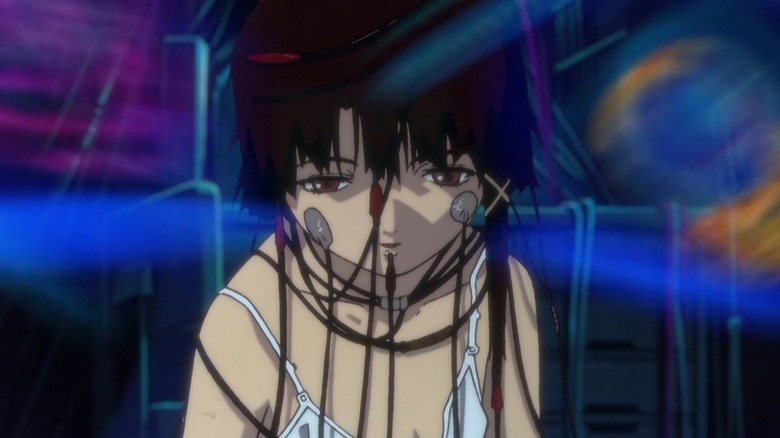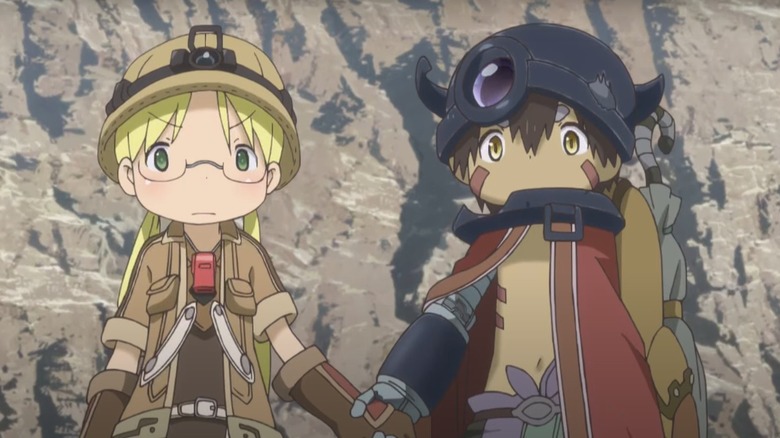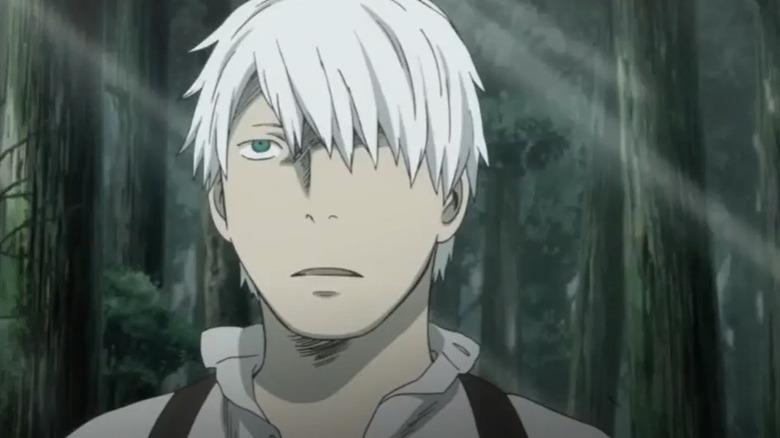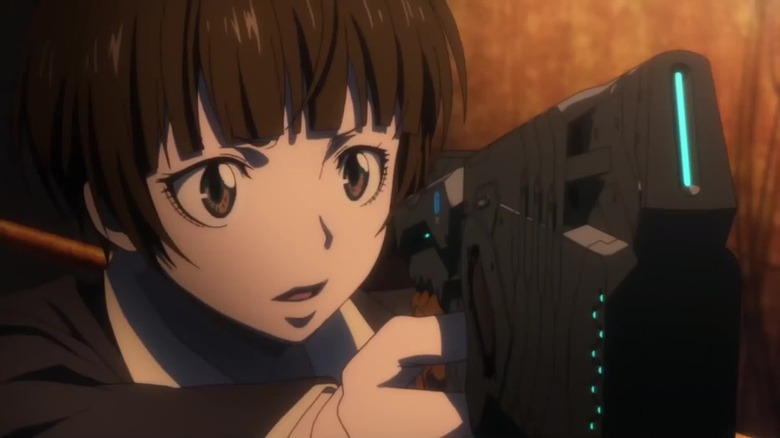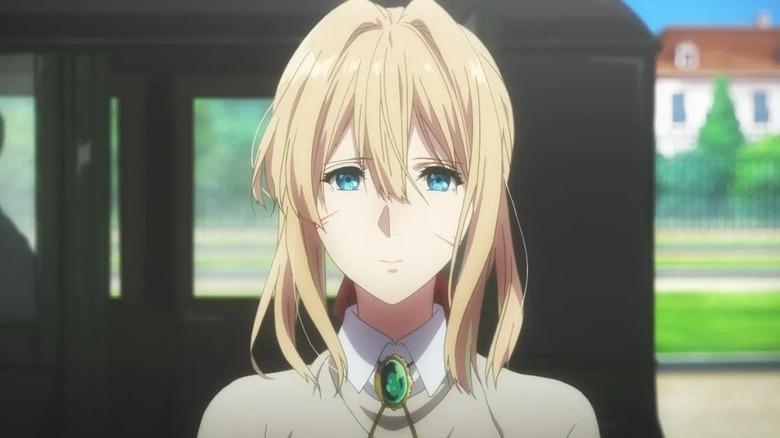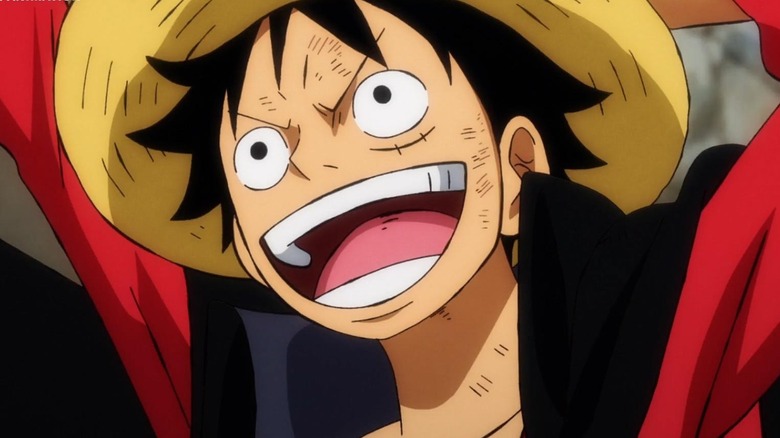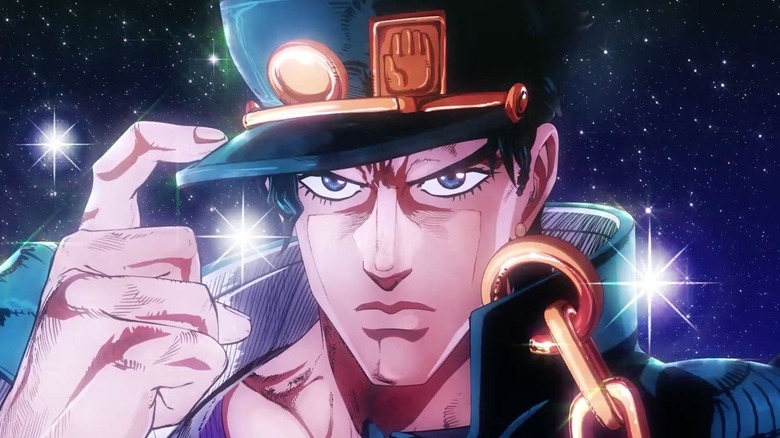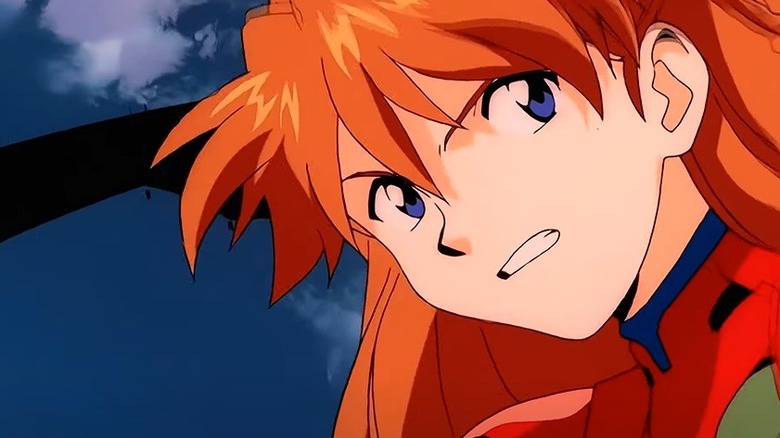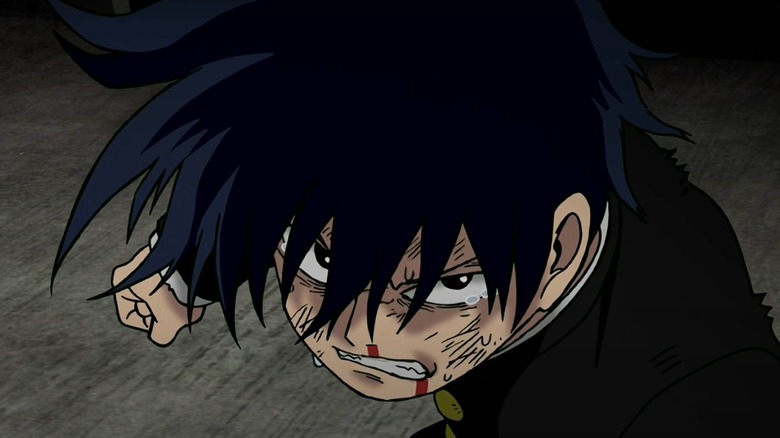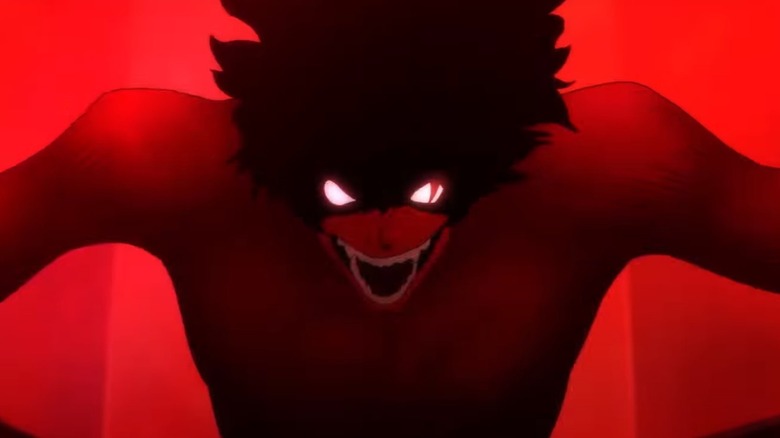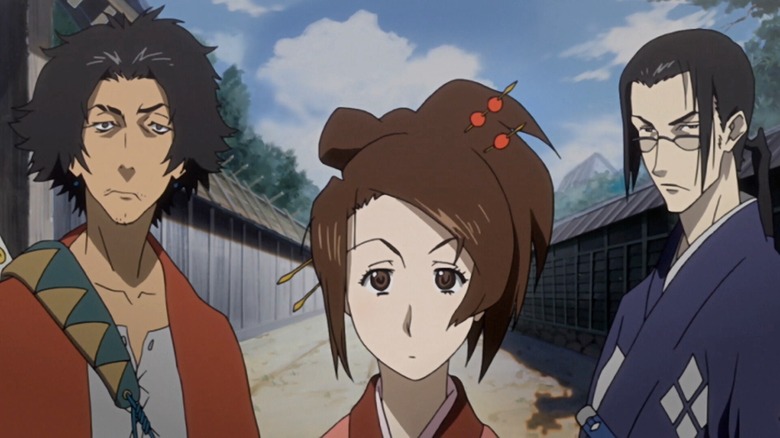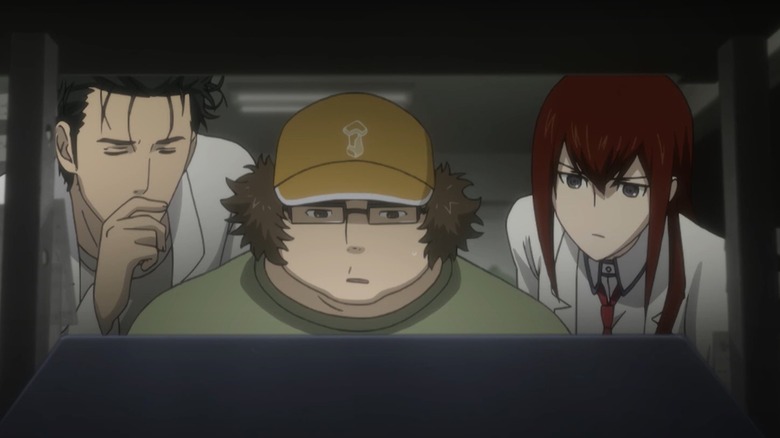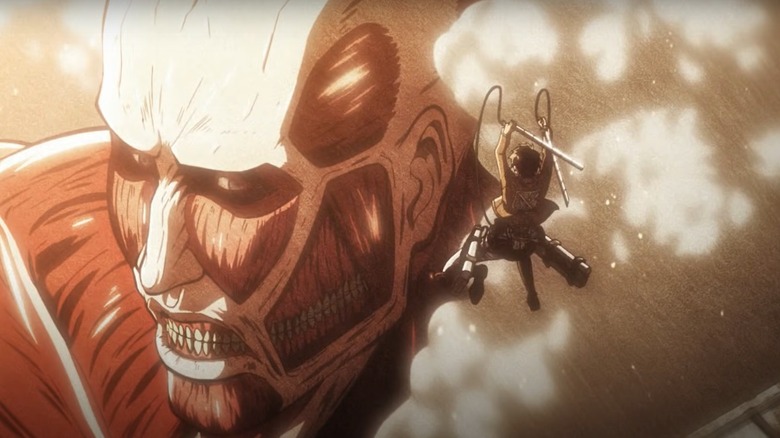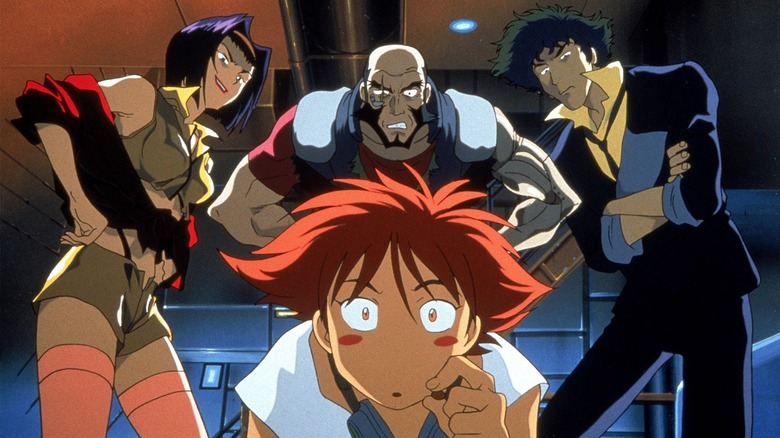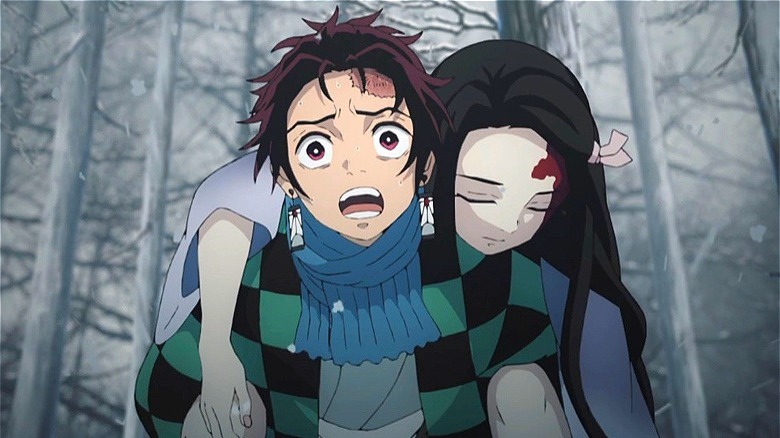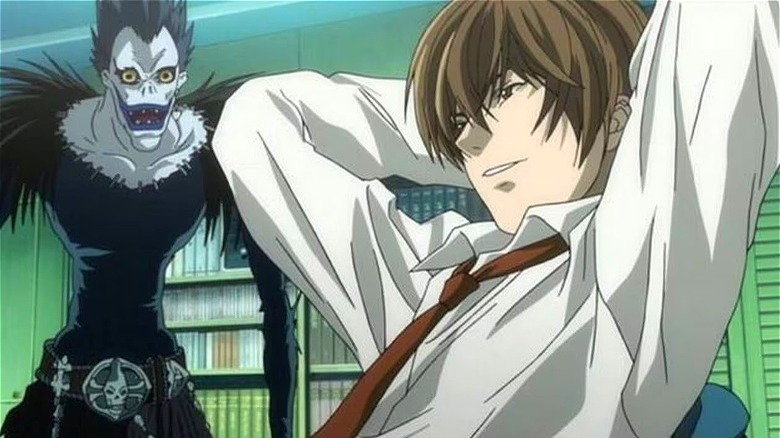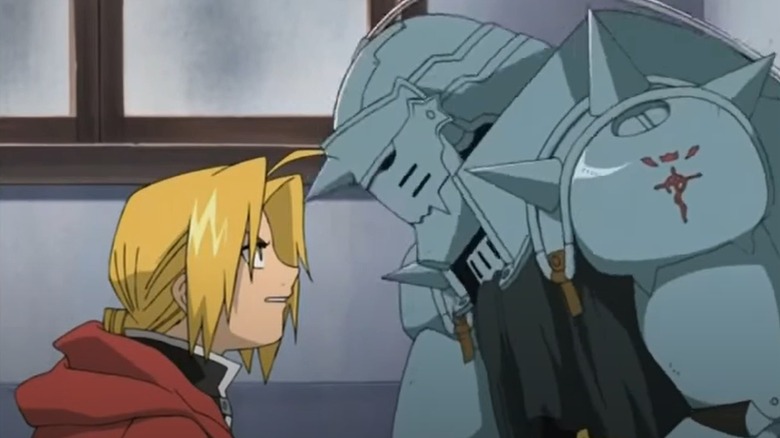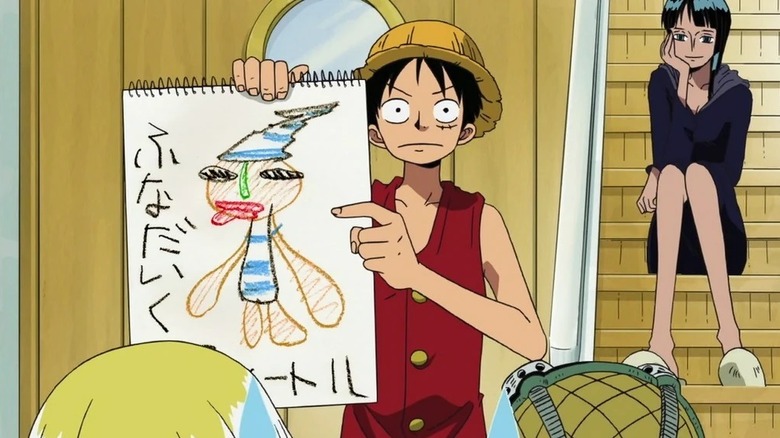50 Best Anime Shows Of All Time Ranked
With so many different genres to choose from, creating a definitive list of the best anime series of all time is no simple task. A show that one viewer sees as being ultraviolent for the sake of it is a masterclass in realism to another. Slice-of-life shows don't appeal to everyone, but to some, there's nothing more comforting. Huge robots doing battle is a bore to many, while others buzz off the idea. From shonen, seinen, and shoujo to mecha, harem, and the ever-popular isekai, there really is something for everyone in the world of anime. However, there are some special shows that transcend the trappings of their genres, and it's those universal crowdpleasers we're going to look at today.
We asked one of our resident anime writers to come up with a list that takes into account everything from entertainment value and originality to cultural impact, and this is the result. From seminal shows that inspired generations of fans and creators to the modern-day classics that stand as a shining example of the medium, here are the 50 best anime series of all time.
Updated on May 16, 2024: While we all love a good classic, innovative and binge-worthy anime series are coming out all the time. Check back here regularly as we'll keep this list updated with new anime series that have become instant hits.
50. Super Dimension Fortress Macross
You may have already seen parts of "Super Dimension Fortress Macross" without even knowing it. Back in 1985, a series called "Robotech" was released in America. This show was a mash-up of three different anime shows, edited together to come up with a new story for U.S. audiences. One of those shows was "Super Dimension Fortress Macross," one of the most influential anime of all time. Aside from being one of the shows that made the Frankenstein's Monster that is "Robotech" a reality, 1982's "Super Dimension Fortress Macross" spawned a whole franchise in Japan, which includes films and OVAs.
While many of the entries that followed are worth your time (the 1994 four-part OVA "Macross Plus" is a must-see), the original series is still the best. Set in the distant future of 2009 (yes, it's that old), it's a space saga about a war with an alien race known as the Zentradi. It all kicks off when one of their ships arrives to inform humankind that a spacecraft they've been reverse engineering (which crash-landed on Earth a decade earlier) belonged to their enemies. When the ship recognizes them, it overrides the humans inside and begins firing on the Zentradi, setting the conflict in motion. What sets "Macross" apart from other mecha shows is the music, which is often used to move the story forward. "Super Dimension Fortress Macross" is jam-packed with ballads and bangers, and it launched the music career of Mari Iijima, who plays idol singer Lynn Minmay in the show.
49. Food Wars!: Shokugeki no Soma
Watching animated people eat animated food is a strangely satisfying experience, and that's particularly true of anime — Ponyo and Sosuke eating ramen will make your mouth water every single time. If food anime is your thing, then look no further than "Food Wars!: Shokugeki no Soma," a show that will get your belly rumbling without fail. With recipes from the renowned Japanese chef Yuki Morisaki, the manga became a hit in its home country, and the anime adaptation from J.C. Staff (the studio behind the likes of "A Certain Magical Index," "Toradora!" and "The Disastrous Life of Saiki K.") was beloved the world over.
It's the story of teenager Soma Yukihira, who dreams of following in his father's footsteps and taking over his restaurant. If he's going to match and eventually surpass his father, he'll have to graduate from Totsuki Saryo Culinary Institute, Japan's most prestigious culinary school. The children of rich and famous chefs study here, and some of them aren't thrilled about having the son of a common cook studying with them. Soma is ready and willing to prove them all wrong — at Totsuki, students regularly engage in competitions called "shokugeki," facing off against one another to see who can come up with the best meal under trying circumstances. Soma's passion for food is infectious, and the show features a large cast of memorable characters. With five seasons to get your teeth stuck into, this anime is a foodie's dream come true.
48. Re:Zero − Starting Life in Another World
"Re:Zero − Starting Life in Another World" actually started its own life as fan fiction on the website Shousetsuka ni Narou, inspired by the light novel series "The Familiar of Zero." It follows a hikikomori (a Japanese term for modern-day hermits who cut themselves off from society) who's suddenly and unexpectedly thrust into a fantasy world. Natsuki Subaru rarely leaves his home, only venturing outside for supplies. He's on his way back from his local convenience store one day when he's transported to a land inhabited by elves, witches, and all manner of magical creatures. He's killed not long after arriving in the Kingdom of Lugnica (one of the Four Great Nations in the "Re:Zero" world), but he regenerates, leading him to the realization that he can alter the past by dying in the present.
With this knowledge, Natsuki decides to help a half-elf named Emilia, who befriended him upon his arrival in this strange new world. She's a contender for the throne of Lugnica, and his powers of regeneration come in very useful. It might sound like your typical isekai, but it's refreshingly self-aware. When he first pops up in Lugnica, Natsuki says, "Is this one of those isekai summoning things?" In fact, the success of "Re:Zero" is partly what led to the isekai boom in the first place. As the Anime News Network explained, "'Konosuba' and 'Re:Zero' proved that Narou isekai novels specifically were worth investing in."
47. Frieren: Beyond Journey's End
If you're a fan of "Dungeons & Dragons" then you need to check out "Frieren: Beyond Journey's End" as soon as you can. It's the touching tale of an elven mage named Frieren, who was a member of a famous party of adventurers that defeated the dreaded Demon King. Their campaign against the villain lasted for 10 years, though that's nothing to an elf — they have extremely long lifespans, so Frieren views the decade she spent with the party as a fleeting thing. However, when one of her former companions dies of old age 50 years after their adventure, Frieren feels an unexpected pang of regret for not spending more time with him and decides to learn more about humans.
During her voyage of discovery, Frieren takes on an apprentice, an orphan girl named Fern. Their partnership makes for some laugh-out-loud moments, with Fern's urge to learn as much magic as she can clashing with Frieren's blasé attitude toward the passing of time. It's a lot of fun, but "Frieren: Beyond Journey's End" also makes you think. The message here is that death comes for us all and we need to appreciate those around us while we can. By the time a new party begins to form around Frieren, she's learned some important life lessons, but can she implement them? It's a fascinating setup, but there's more to the show's success than that: The animation from veteran studio Madhouse is top notch, and the beautiful score fits the fantasy setting perfectly.
46. Spy x Family
Based on the manga series of the same name by Tatsuya Endo, "Spy x Family" took the anime world by storm when it debuted in 2022, scoring rave reviews and quickly amassing a passionate fanbase. The show follows a fake family who don't know the truth about each other but grow close nonetheless. It all begins when a spy who goes by the name Twilight disguises himself as a psychiatrist named Loid Forger in order to investigate an inscrutable politician named Donovan Desmond. As part of his cover, he drafts in a woman named Yor to act as his wife and an orphan girl named Anya, who is supposed to be their daughter. What Loid doesn't know is that Yor is actually a deadly assassin called Thorn Princess and Anya has telepathic powers.
The Forgers also have a pet Pyrenean Mountain Dog named Bond, who can see the future thanks to his past as a canine test subject at Project Apple. This makes for plenty of humorous moments, and the comedy aspect of "Spy x Family" is undoubtedly one of the show's biggest strengths, though the espionage backdrop makes it stand out in the increasingly crowded genre. What also helps "Spy x Family" differentiate itself from other action-comedy hybrids is that it's largely centered on adults rather than kids and/or teens, giving the show a broad appeal. The second season, which dropped in 2023, is just as gripping as the first, meaning the future looks bright for this burgeoning family-friendly franchise.
45. Assassination Classroom
"Assassination Classroom" follows a class of middle school rejects tasked with saving the world from a yellow, tentacled alien. The creature destroys most of the moon (turning it into a permanent crescent) and then comes to Earth, where he insists on taking over as the teacher of Class 3-E. He begins molding the low-achieving students into skilled assassins and claims that Earth will meet the same fate as the moon if the students cannot kill him by the end of the school year. He's super fast and nigh-on impossible to kill, but he's also the best teacher the kids have ever had — he drastically improves their grades and brings them out of their shells, gaining their trust and admiration.
On the surface, "Assassination Classroom" seems totally bonkers, but it's actually a wholesome and hilarious story about underestimating kids. While the motives of this strange alien (who went by the name "The Reaper" before being redubbed Koro-sensei, meaning "unkillable teacher") are unclear to begin with, it soon becomes obvious that there's a lot more to him than mindless destruction. "Depending on how you utilize the complexes you have about yourself, you can do incredible things," Yusei Matsui, creator of the original manga, told ComicBook.com. "When you look at that with the kids in 3-E, it's not as if they all have superhuman abilities, but Koro-sensei gives them the opportunity and a different way of looking at their situation."
44. Sailor Moon
"Sailor Moon" didn't invent the magical girl genre, but it helped to reinvent it. Mahou shoujo became a thing in anime thanks in part to the success of the American sitcom "Bewitched," and its influence in early offerings is apparent: The protagonists of these shows are all typical girly-girls who use their magic for cutesy purposes. "Sailor Moon" threw this out of the window with its protagonist Usagi Tsukino, an underachieving school girl. After being granted magical powers by a talking cat called Luna, Usagi adopts the Sailor Moon moniker and sets out on a quest to find the moon princess. Her ultimate goal is to bring an end to the tyranny of Queen Beryl, the leader of the Dark Kingdom.
The characters in "Sailor Moon" stood apart from similar shows because they came with "real personalities, real issues, and overcame these with strength, like warriors," says Complex. "Why is this important? After 'Sailor Moon,' other shows followed suit, and so was born an age of dope, female, warrior anime." Sure, there's some filler (with 200 episodes, there's bound to be), but the influence of "Sailor Moon" cannot be denied, and not just when it comes to magical girl stories. The fashion of the show also had a big impact, and it was also an early example of LGBTQ+ representation in anime: While their relationship was edited out in the American version, Sailor Uranus and Sailor Neptune are together in the original show.
43. Hunter x Hunter
A classic shonen title that began serialization in Weekly Shonen Jump in 1998, Yoshihiro Togashi's "Hunter x Hunter" follows a boy named Gon Freecss, who goes on a fantastic adventure after he finds out that his absent father is actually a famous Hunter. In Togashi's world, Hunters are people who make a living tracking down dangerous villains, rare animals, legendary treasures, and all manner of hard-to-find things. Gon's father Ging Freecss is a Double Star Ruins Hunter, and the youngster has his work cut out for him if he's going to live up to his dad's reputation.
Nippon Animation made a "Hunter x Hunter" anime in 1999, which lasted for 62 episodes. While it's definitely worth your time (especially if you prefer a darker color palette), the general consensus is that the 2011 remake from Madhouse is superior. It's more in-depth at 148 episodes and feels a lot more fresh. It ticks all the shonen boxes, but it sets itself apart from many of its competitors in the genre in several ways. Perhaps chief among them is the power system, which is well-defined and easy to understand, unlike a lot of similar shows. There's also the fact that the antagonists are far more rounded than many shonen baddies, with clearly defined goals that are actually relatable in a lot of cases.
42. Fate/Zero
The "Fate" franchise contains a bunch of different manga and anime, but it all started with a visual novel back in 2004. "Fate/Stay Night" follows Shirou Emiya, a teen who accidentally becomes involved in the Fifth Holy Grail War. These wars are contests in which mages summon heroes of legend (such as Gilgamesh and Lancelot) to compete for the chance to obtain the power of the Holy Grail, with both the mage and the hero getting a wish granted by the Grail should they emerge victorious. An anime adaptation of "Fate/Stay Night" from Studio Deen aired in 2006 and was relatively well-received, but the best anime series in the franchise is undoubtedly "Fate/Zero."
Based on the visual novel of the same name, "Fate/Zero" is a prequel story covering the Fourth Holy Grail War. It takes place a decade before the events of the original series and sees the wealthy Einzbern family hire the renowned freelance mercenary Kiritsugu Emiya — nicknamed the Magus Killer — to represent them in the war. To sweeten the pot, they offer the hand of their only daughter Irisviel in marriage. "Fate/Zero" is darker than the other installments in the franchise and is widely seen as the strongest of the bunch. Made by Ufotable (the animation house behind the critically acclaimed "Demon Slayer the Movie: Mugen Train"), it looks fantastic and deals with interesting questions about morality.
41. Captain Tsubasa
The influence of Yoichi Takahashi's soccer manga "Captain Tsubasa" cannot be understated. A fan of the sport himself, Takahashi created "Captain Tsubasa" — the story of Tsubasa Ozora, a soccer-obsessed kid who dreams of representing Japan at the FIFA World Cup — in the hopes of igniting an interest in soccer in his home country. "I thought football was very interesting and wanted to see it become a popular sport in Japan," he told Al Jazeera. "I wanted the national football team to become stronger. In that sense, I wrote this book for the Japanese audience, explaining football in more detail." In 1983, two years after the manga debuted in Weekly Shonen Jump, an anime adaptation dropped on TV Tokyo. The show went on to inspire youngsters to play soccer, and not just in Japan.
Dubbed versions of the show (in which the titular character was renamed Oliver Atom) aired all over Europe, encouraging future stars of the game like Fernando Torres, Lukas Podolski, Alessandro Del Piero, and Alexis Sanchez. "I started playing football because of this," Torres once admitted. "I loved the cartoon. I wanted to be Oliver." Torres would end up finishing his career in Japan, making 35 appearances for Sagan Tosu. Several new adaptations of the manga have come out over the years, the most recent in 2018 by way of David Production. The animation is inevitably far more crisp, and the fact that soccer is now well established in Japan means it has a ready-made audience, but the original series is still the most charming of the bunch.
40. Fruits Basket
Blending supernatural themes with romance and drama, Natsuki Takaya's manga series "Fruits Basket" has a unique premise. It follows a teenage orphan girl named Tohru Honda, who moves in with her grandfather after the death of her mother. When her grandfather is forced to renovate their house she needs to move again, and the kind-hearted Sohma family agrees to take her in. She soon discovers that this large family has a bizarre secret: They are cursed to transform into an animal from the Chinese zodiac whenever they're embraced by a member of the opposite sex. It sounds like a set up for a comedy, but, while it certainly has its humorous moments, the manga touches on some serious themes.
"Fruits Basket" was first adapted into an anime series by Studio Deen back in 2001, but it deviated from the manga in places and Takaya reportedly didn't like many of the decisions made by director Akitaro Daichi. The story was never wrapped up, and for a long time it appeared as though fans would never get the proper adaptation that they craved, but in 2019, a new anime from TMS Entertainment was released. The creators got it spot on this time, and the show went down well with fans. There have been two more seasons since then, with the third and final one (released in 2021) a firm favorite on My Anime List.
39. Pokémon
No Japanese export has impacted pop culture in the way that "Pokémon" has. What began as a pair of twin games on Nintendo's original Game Boy quickly grew into the highest-grossing media franchise of all time (it's made over $100 billion globally), spawning several video games, a hugely popular trading card game, numerous films, and, of course, a long-running anime series. Viewers were able to follow the adventures of Ash (Satoshi in the Japanese version, named after franchise creator Satoshi Tajiri) and his trusty sidekick Pikachu for 25 years, with the long-running series coming to a close in 2023.
The first season of the "Pokémon" anime may not be a masterpiece of storytelling or a benchmark in animation, but it holds a special place in the hearts of '90s and '00s kids and for good reason. It might sound odd to use the term "more believable" when talking about battling creatures that reside in little red and white balls, but the original 150 Pokémon designs are exactly that — less outlandish and made with particular functions in mind. Unfortunately, the line between Pokémon types became blurred as the years marched on, with the designers seemingly running out of ideas, leaving fans wistful for 1997. After all, with its iconic theme tune and unforgettable characters, the "Indigo League" series remains the very best.
38. Elfen Lied
"Elfen Lied" follows a Diclonius (a mutated species of human with invisible telekinetic appendages known as Vectors) by the name of Lucy. The story begins when Lucy escapes from the government facility she's being housed in, brutally killing many of her captors in the process. She's injured during the escape, however, and she develops a split personality as a result. While Lucy has been hardened by the inhumane experimentation she was subjected to behind closed doors, her second personality (Nyu) is sweet and innocent. It's this side of her that Kouta and Yuka — the sympathetic locals who give her shelter — get to know. Together, they aim to protect their new friend from the government agents hunting her down.
If the plot sounds remarkably similar to "Stranger Things," that's no accident. The anime was "really influential," co-creator Matt Duffer told The Daily Beast. "When I watched it, I thought it felt like an ultraviolent 'E.T.' There were a lot of things in there that I really liked and that made their way into the show, particularly related to the character of Eleven." The Duffers weren't the only ones to fall in love with the series. It became a big crossover hit when it arrived in the States in the mid-'00s, and while its popularity has waned somewhat in the years since (largely due to the fact that fans feel as though 13 episodes just wasn't enough), it's still a seminal show that shouldn't be missed.
37. Vinland Saga
Based on Makoto Yukimura's manga of the same name, "Vinland Saga" takes place in Danelaw, the area of northern England that was settled by the Vikings after they began arriving in the British isles en masse. Set against a backdrop of King Cnut the Great's rise to power, the story follows teenage warrior Thorfinn as he attempts to avenge the death of his father. They were on their way to England together when they were attacked by a man named Askeladd, the leader of a small but formidable band of Vikings. In the hope of one day challenging him to a duel, Thorfinn joins Askeladd's group.
"Vinland Saga" was nominated in nine categories at the 2020 Crunchyroll Anime Awards, winning best drama. The Wit Studio show has built a dedicated following since it debuted in 2019, and has already established itself as one of the best executed anime series of all time. Some have gone as far as calling it a modern masterpiece. "The story is one the most complex, well developed, and sympathetic stories I've ever seen," one Redditor said. The second season, which came out in 2023, received a more mixed reaction (many fans complained about the lack of action compared to the first season), but those who stuck around through all the farming episodes were rewarded with a "well written emotional story with probably the best character development I've seen in an anime," said u/Keshan345.
36. Paranoia Agent
The only original anime series from the late, great Satoshi Kon (the genius behind such feature films as "Perfect Blue," "Millennium Actress," "Tokyo Godfathers," and "Paprika"), 2004's "Paranoia Agent" is a unique tale that follows a large group of people who've all been affected by the same social phenomenon. It begins when stressed-out character designer Tsukiko Sagi is attacked by a baseball bat-wielding child thug while walking home late one evening. She doesn't see the face of her assailant; all she knows is that he was around elementary school age, wore a pair of golden rollerblades, and had a bent, golden baseball bat for a weapon.
It's an unlikely story, and as such, the cops don't believe her, assuming that the character designer's overly active imagination is simply running wild. When further attacks start happening and the victims describe what seems to be the same boy, however, the authorities are forced to take it seriously. Fear of being attacked by Shonen Bat (or Lil' Slugger in the English version) starts to spread, and we're given a window into the lives of his unrelated victims. With just 13 episodes, this show is perfect for binging, and it still hits as hard today. "Anime auteur Satoshi Kon brings his feverish vision to the serialized form in 'Paranoia Agent,' a disturbing meditation on individual and societal anxiety," reads the Critics Consensus on Rotten Tomatoes, where it holds a perfect 100% rating.
35. Berserk
Based on the beloved, long running manga series by Kentaro Miura (who sadly died from a heart condition in 2021 at the age of 54), "Berserk" is a critically acclaimed seinen series from OLM. The studio is best known for "Pokémon," but "Berserk" couldn't be further from that show in terms of its content. This bloody, brutal series follows a lone wolf named Guts, who was brought up to be a mercenary by his no-good adoptive dad. After killing him in self defense, Guts wanders a medieval Europe-like land, selling his services to the highest bidder. His fierce reputation piques the interest of Griffith, the leader of the mercenary group the Band of the Falcon (which Miura named after the Millennium Falcon). When Griffith unexpectedly defeats Guts in battle, the latter agrees to join his band, and Guts quickly becomes Griffith's right hand man in his quest to rule his own kingdom.
OLM's anime dropped in October 1997 and ran until April 1998, spanning 25 episodes and covering the well-known Golden Age arc from the manga. It's not the only adaptation: A trilogy of anime films (also based on the Golden Age arc) dropped between 2012 and 2013, and a new series (acting as a sequel to the films) aired between 2016 and 2017. The films and the follow-up series are must-sees for "Berserk" purists, but they pale in comparison to the brilliance of the original anime. It has drawn comparisons to "Game of Thrones," the work of horror author Clive Barker, and the RPG video game series "Dark Souls."
34. Mobile Suit Gundam
Giant robots have been a thing in anime since the 1960s, but the foundations of the mecha genre as we know it today — with humans hopping inside big, humanoid vehicles to do battle — were laid by the "Gundam" franchise. 1979's "Mobile Suit Gundam" was a game changer in that the titular mechas were designed to be as realistic as possible. Prior to this, the robots seen in anime were usually sentient as opposed to being pieces of machinery. Today, there are several dozen "Gundam" series, films, and OVAs to choose from, and it's hard to put a finger on which is the best of the bunch as it comes down to personal choice, but the original series remains a must-see and still holds up well.
"Mobile Suit Gundam" is set in the far future and is about a war between the Earth Federation (a global government) and the Principality of Zeon (a space colony located behind the moon). When Zeon declares independence from Earth, a conflict that will claim the lives of half of all humanity erupts. Despite being much smaller than Earth, Zeon has the upper hand due to its advanced mobile suits. Earth develops a suit of its own — the RX-78-2 Gundam — at another colony in order to level the playing field, but the crew sent to collect it are nearly annihilated en route to collecting it, along with many citizens. It falls to Amuro Ray, the 15-year-old son of the man who created the RX-78-2 Gundam, to pilot the mecha and fight Zeon.
33. Bleach
Based on Tite Kubo's original manga series of the same name, Studio Pierrot's hit shonen series "Bleach" follows a high school student who becomes a Soul Reaper, beings whose role is to guide the souls of the departed into the afterlife. Ichigo Kurosaki gets his newfound powers after a chance encounter with a Hollow, the evil spirits of the series. During the confrontation, a Soul Reaper named Rukia Kuchiki shows up and transfers her powers to Ichigo, turning into a substitute Soul Reaper. It follows Kubo's manga for the most part, though there are some anime original story arcs, too.
"Bleach" debuted in 2004 when shonen shows were all the rage. It soon became known as one of the Big Three (with "One Piece" and "Naruto" being the other two), gaining a dedicated fanbase. The original series ran until 2012, racking up 366 episodes in that time. It came to be known as the weakest of the Big Three in the years that followed, but the series came back with a bang in 2022 when the belated sequel series "Bleach: Thousand-Year Blood War" dropped. The comeback show has proven to be extremely popular with fans and critics alike, sitting comfortably in the top ten highest-rated series on My Anime List. Part 2 (subtitled "The Separation") arrived to equally enthusiastic reviews in 2023.
32. Slam Dunk
There are plenty of basketball anime out there, but the king of the court is undoubtedly "Slam Dunk." The anime series, based on Takehiko Inoue's manga of the same name, debuted in 1993 and ran for over a hundred episodes. It follows the journey of Hanamichi Sakuragi, a troublemaker and underachiever who laments his lack of luck with the ladies. He only gets into basketball after a girl he likes asks him about it, but he soon falls in love with the sport. His natural athleticism makes him a great addition to the Shohoku High School team, which begins a meteoric rise from obscurity to nationwide fame with his help.
Of course, these plot beats mirror most basketball anime, but what sets "Slam Dunk" apart is its dedication to capturing the passion and drama of the sport. Inoue is a huge basketball fan and is "credited by some with having popularized basketball amongst a whole generation of high school students," said CNN. "In 2010, Inoue received a commendation from the Japanese Basketball Association, for his services to the sport." The franchise remains as popular as ever today — a feature film called "The First Slam Dunk" dropped in Japan in 2022 and did huge numbers at the box office, surpassing the likes of Studio Ghibli's "The Wind Rises."
31. Fighting Spirit
George Morikawa's boxing manga "Hajime no Ippo" (meaning "The First Step") is the story of Ippo Makunouchi, a shy boy who becomes a force in the ring following a chance encounter. After a professional boxer named Mamoru Takamura happens to witness him taking a beating from some local bullies, he takes Ippo to his gym to treat his wounds. When the boy takes his frustrations out on the punching bag, Mamoru realizes he has some raw talent and Ippo's journey to the top begins.
"Hajime no Ippo" began serialization in Weekly Shonen Magazine in 1989 and is still a favorite among lovers of sports manga to this day — it reached a remarkable milestone in 2021, when the magazine confirmed that over 100 million copies were in circulation. An anime series from Madhouse came out in 2000, which made its way to North America under the name "Fighting Spirit." It ran for 75 episodes and spawned two sequel seasons, subtitled "New Challenger" and "Rising," respectively.
The first season remains the most compelling: With a score of 8.76 on My Anime List, it sits inside the top 40 highest-rated shows on the website, one spot above the beloved classic "Cowboy Bebop" at the time of this writing. What makes it so great is that it's about more than just boxing. "The sport is a conduit for character growth, literal trials, and tribulations," explains Otaquest. "We watch as Makunouchi goes from a shy, bullied boy to an absolute powerhouse who literally kicks ass."
30. Code Geass: Lelouch of the Rebellion
"Code Geass: Lelouch of the Rebellion" takes place in an alternate timeline where the planet is divided into three superpowers. Europe and Africa have joined forces and go by the name Europa United, Asia is now known as the Chinese Federation, and the Americas are called the Holy Britannian Empire. In this world, the fictional Queen Elizabeth III fled to her Stateside colonies after her forces got trounced by Napoleon at the Battle of Trafalgar, and she never returned. We enter the story as the expansionist Britannian Empire (now led by Emperor Charles zi Britannia) is launching an assault on the Japanese islands, and they're causing havoc.
The invaders from the West seek to strip the Japanese people of their culture and freedoms, rechristening the country Area 11 and dubbing its inhabitants "Elevens," which, needless to say, does not go down well with the locals. It falls to Lelouch (an exiled Britannian prince who's been living in Japan since falling out with his dad over the death of his mother) to save his adopted country from his tyrannical father. Lelouch adopts the moniker Zero and becomes a masked vigilante, giving the Japanese people a symbol of hope. With the help of his rebel group, The Black Knights, he leads the fight against the Brittanians. It's a sweeping tale of family, loyalty, and revenge that grows on you the longer you stick with it.
29. My Hero Academia
We live in a time saturated with superheroes, and so does Izuku Midoriya, the protagonist of "My Hero Academia." In his world, an estimated 80% of the population has some kind of Quirk (the in-universe term for a superpower), though Izuku is one of the unlucky 20% who doesn't. He was born with no powers whatsoever, though that never stopped him from wanting to become a hero. His tenacity wins him favor with Japan's most famous hero, All Might, who decides to take him under his wing and help him secure a place at U.A. High School, Japan's top heroics institution. We soon learn that, like Izuku, there's a lot more to All Might than meets the eye.
Based on the manga by Kohei Horikoshi — who's a huge fan of American superheroes and once went to see "The Amazing Spider-Man 2" dressed as Spider-Man — "My Hero Academia" is still ongoing at the time of this writing, and it shows no signs of slowing down. The series ended the 2010s with a bang (All Might's throwdown with the show's big bad, All for One, is a thing of legend) and things have only gotten more intense since then: The most recent season covers the Star and Stripe arc, in which America's top hero comes to the aid of All Might. If you're an American anime fan who still hasn't given "My Hero Academia" a chance, there's never been a better time to catch up.
28. Gurren Lagann
2007's "Gurren Lagann" was the brainchild of former Gainax staffer Hiroyuki Imaishi, who went on to found Studio Trigger on the back of the mecha show's success. It takes place in a world in which humans are forced to live in underground villages by a tyrant named Lordgenome, aka The Spiral King. Lordgenome's soldiers, humanoid creatures known as Beastmen, pilot machines called Gunmen, the main type of mecha in the series. They use these to keep the humans in check, though many prefer to fight on land rather than retreat below it.
The series follows two teenagers named Simon and Kamina, who long to visit the surface world. They get the chance to do so after a Gunmen crashes through the surface into their village during a battle with a gun-wielding human girl named Yoko. Inspired, they decide to use a smaller Gunmen that they discovered underground to go to the surface and join the fight. After Kamina manages to steal a larger Gunmen, they combine the two and name it Gurren Lagann.
Dubbed "emotionally resonant and outright epic" by Collider, the series received widespread acclaim for everything from its themes and visual humor to its art style, which would become the calling card of Trigger works. To this day "Gurren Lagann" retains a 100% rating on Rotten Tomatoes and boasts a score of 8.63 on My Anime List, where it has over 1.5 million members.
27. Black Lagoon
The 1990s-set seinen series "Black Lagoon" was a big hit when it dropped in 2010, and it's now considered an anime classic. Based on the manga of the same name by Rei Hiroe, it's both a raucous story about modern-day pirates and a stinging critique of capitalism. It follows 25-year-old Japanese salaryman Rokuro "Rock" Okajima, who gets taken hostage by the crew of the titular ship. When his boss decides to declare him dead as opposed to paying him ransom, Rock joins the crew, which consists of former U.S. Navy man Dutch, gun specialist Revy, and mechanic/computer wizkid Benny. From their base in Thailand, the Lagoon Company takes on missions for any criminal organization willing to meet their asking price.
What's great about "Black Lagoon" is that the protagonists are morally ambiguous but never unlikeable. Even Rock, who for the most part maintains his good nature, begins to understand that nice guys often finish last in this cut-throat world run by gangsters and corrupt businessmen. There's no good versus evil here, just survival. The series has drawn comparisons to the work of Quentin Tarantino and John Woo, and if you're a fan of either filmmaker, you're sure to get a kick out of this frenetic and darkly funny anime. It looks fantastic, too — South East Asia is brought to life brilliantly by Madhouse, Geneon Entertainment and Shogakukan, who came together to make an all-time great anime.
26. Dragon Ball Z
The often-overlooked original "Dragon Ball" series (based on Akira Toriyama's manga of the same name) was among the best anime of the 1980s, but in terms of cultural impact, it pales in comparison to "Dragon Ball Z." The beloved sequel series ages up the main character significantly. Goku was a whippersnapper in "Dragon Ball," but here, he's a young adult with a child of his own, father to the equally badass Gohan. Together, they must fight to stop an alien race to which they unknowingly belong. When a Saiyan named Raditz shows up on Earth, he drops a huge truth bomb on Goku — they are brothers by blood, and Goku's real purpose is a sinister one indeed.
The Saiyans sent Goku (whose real name, it turns out, is Kakarot) to Earth to conquer the planet in their name many moons ago, but he suffered a head injury when he landed, causing a pretty bad case of amnesia. Goku forgot all about his mission and grew up believing himself to be a member of the human race rather than an invader trying to overthrow it. Now, he'll defend his adopted planet at any cost, leading to some ridiculously cool battles. Subsequent sequel series "Dragon Ball GT" and "Dragon Ball Super" have plenty to offer the diehard shonen fan, but if you're only going to watch one "Dragon Ball" series, make it "Dragon Ball Z."
25. One-Punch Man
If you're starting to feel superhero fatigue kicking in, you're not alone — the hero of the hit webcomic turned anime "One-Punch Man" is feeling it too. Saitama is so powerful that he can defeat any foe with (you guessed it) just a single punch, and it's left him feeling rather jaded. "Punching is oftentimes pretty useless against life's problems," the character's creator, who goes by the name ONE, told ComicBook.com. "But inside One-Punch Man's universe, I made Saitama a sort of guy who was capable of adapting his life to the world that surrounded him, only armed with his immense power. The only obstacles he faces are mundane things, like running short of money."
The set-up makes for some great comedy, but this is an anime with something for everyone. The battles are both imaginative and intense, especially after the alien invader Boros arrives on the scene (spoiler alert — he survives Saitama's punch). We come for the laughs and the punches, but the heart of the show lies in Saitama's relationship with Genos, whose family was killed by a cyborg villain. Saitama becomes a reluctant mentor to the up-and-coming hero, who's out for revenge for his family and his city, which was razed to the ground by the killer.
24. Naruto
Even if you're not familiar with anime, chances are you've heard of Naruto — or, more particularly, his iconic sprinting style. The so-called "Naruto run" gained international attention in 2019 when a prankster did one during a news report from Area 51, bringing a bunch of new fans to the classic anime. It's the tale of ambitious young ninja Naruto Uzumaki, who longs to become the head (or Hokage) of his village. He's not exactly a popular choice, however — when Naruto was a baby, Kurama (aka the Nine-Tailed Fox) attacked the village, and Naruto's father was forced to seal the demon inside his son. This leads to Naruto being largely shunned by his peers, but he remains determined to prove himself a worthy leader.
Like Masashi Kishimoto's manga, the anime is told in two parts: "Naruto," which deals with the titular character's pre-teen years, and "Naruto: Shippuden," in which he comes of age. While the sequel series sometimes gets the nod from fans due to its superior animation, both are brilliant and worth your time. People have been debating which is better for years, to no avail. "As a teen, I always thought 'Shippuden' was better because of their power ups, new designs, and bigger battles," said one viewer when the debate blew up on Reddit in 2021. "Now looking back (I'm in my mid-20s now), OG 'Naruto's' story felt more cohesive." We'll let you be the judge.
23. Monster
"Monster" is the gripping tale of Dr. Kenzo Tenma, a Japanese brain surgeon working in Germany during the Cold War. He's stationed in the West German city of Düsseldorf, where patients from the East tend to receive poorer levels of treatment. Tenma becomes an outcast after he refuses to abandon an East German child in favor of treating a West German politician, though he soon comes to realize that this maybe wasn't the smartest move — the kid he saves is Johan Liebert, who turns out to be a serial killer. When the doctors that turned on Tenma start turning up dead, the foreigner becomes a suspect, but police can find no evidence against him. Almost a decade passes as Tenma manages to rebuild his life, but Liebert reemerges, and the Japanese doctor is once again suspected of committing his crimes.
The series raises some interesting questions about the obligations of medical professionals, but it lets viewers make up their own minds. The story was inspired by "The Fugitive" (the David Janssen-led TV series), which left quite the impression on the creator of the original manga, Naoki Urasawa. "I watched it when I was about 8," he told All the Anime. "The story is that a doctor is accused of murder, the detectives are chasing him and he must run away. That storyline really had an impact on me." Fans of the cult American TV show and the Harrison Ford-led remake movie will no doubt love "Monster" too.
22. Gintama
If you like samurai sagas and science fiction, then "Gintama" is the anime for you. Based on Hideaki Sorachi's hit manga, it takes place in an alternate version of Japan's Edo period, one in which aliens called Amanto have taken control. Terrified by the might of the Amanto (meaning "Sky People"), the shogun backs down and allows the invaders into his country, but the proud samurai won't roll over so easily. Despite the puppet shogun imposing a ban on carrying swords, freelance samurai refuse to abide by the cowardly new laws and set about ridding Earth of these unwanted alien pests. One such samurai goes by the name of Gintoki Sakata. He's the focus of the series, but he doesn't work alone.
After stumbling across a bunch of aliens trying to send a human girl to a brothel, he springs into action and cuts them down, earning the respect and admiration of her brother, Shinpachi. In awe of his sister's rescuer, the bespectacled samurai-in-training joins Gintoki's team. Not all the aliens are bad, however — his crew is later bolstered by the extraterrestrial teen Kagura, who comes from a particularly badass alien clan. It's mainly lighthearted in nature, but what sets "Gintama" apart from similar shows is the emotional clout it often (and sometimes without warning) brings to the table. The series wrapped with the feature-length film "Gintama: The Final," which was one of the best anime movies of 2021.
21. Ghost in the Shell: Stand Alone Complex
The "Ghost in the Shell" film is considered a seminal classic (the 1995 anime film, that is — not the whitewashed live-action Hollywood version), but too many people seem to overlook "Ghost in the Shell: Stand Alone Complex," which dropped to critical acclaim in 2002. While the 1995 film followed Public Security Section 9's hunt for the Puppet Master, "Ghost in the Shell: Stand Alone Complex" concentrates on a different villain from Masamune Shirow's manga. Cybernetic protagonist the Major (full name Major Motoko Kusanagi, a counter-cyberterrorist ace and the field commander of Section 9) goes after the terrorist group the Individual Eleven, as well as the cyber hacker the Laughing Man, in this gripping series.
"Ghost in the Shell: Stand Alone Complex" boasts some fantastic animation from Production I.G., the studio behind such shows as "Psycho-Pass," "Eden of the East," and "Haikyu!!" It sees the members of Section 9 uncover corruption within other branches of the Japanese government, and it expands on many of the philosophical questions posed in the manga. "The difference between human and machine grows ever more blurred in this anime vision of things to come," The Guardian said in its review. "If only all sci-fi was this good." It's a binge-worthy show, but don't fear — once you've devoured all 26 episodes, a second season ("Ghost in the Shell: S.A.C. 2nd GIG") set two years after the first will fill that void.
20. Haikyuu!!
Haruichi Furudate's award-winning manga series "Haikyuu!!" follows student Shoyo Hinata on his journey to becoming a top volleyball player. He's not the biggest guy on the court, but he's inspired by a renowned player known as The Little Giant, who dominates games despite his size. After seeing The Little Giant playing on TV he decides to join his junior high school's volleyball club — only to discover that he's the only one on the team. Shoyo's friends agree to make up the numbers, but they get hammered by a team led by the highly skilled Tobio Kageyama. When both Shoyo and Tobio end up at the same high school (the one formerly attended by The Little Giant) they put their brief rivalry behind them and develop a relationship that will put their once-great school back on the volleyball map.
An anime adaptation from Production I.G. began airing in 2014 and became an instant hit. Three more seasons came out between then and 2020, with the show seemingly picking up more fans with each one. "Haikyuu!!" was named Anime of the Year at the 2021 Anime Trending Awards, and it also took home Best Boy at the Crunchyroll Anime Awards that same year, with Shoyo beating out competition from the likes of Satoru Gojo from "Jujutsu Kaisen" and Khun Aguero Agnes from "Tower of God." At this point, "Haikyuu!!" is such a big deal that a number of real-life volleyball stars count themselves as fans, including South Korea's Kim Yeon-koung and Brazil's Alan Souza. Like many others, they're hooked by the dynamic animation and the high drama of this addictive and inspiring series.
19. Parasyte: The Maxim
Plenty of anime shows switch between feel-good vibes and ultraviolence, but few do it as skillfully as "Parasyte: The Maxim," one of the most memorable horror anime of all time. Based on the manga by Hitoshi Iwaaki, it's the story of 17-year-old high school student Shinichi Izumi, who's forced to coexist with an alien. The anime opens with a race of parasitic extraterrestrials arriving on Earth. The small, worm-like creatures enter human bodies through nostrils and ears, burrowing into the brain and turning the unsuspecting victims into hosts. They maintain a human shape to keep their presence a secret, but they're able to transform into truly monstrous forms at will.
Luckily for Shinichi, he went to bed listening to music the night the aliens arrived. The parasite that attempted to take over his body was denied entry by his headphones, and when it tried to get in via his nose, the tickling sensation made him sneeze. He woke up, and in a panic, the creature burrowed into his hand instead. The quick-thinking teen used the wire of his headphones to make a quick tourniquet, stopping the invader from getting to his brain. It took over his right hand instead (he ends up calling it Migi, meaning "right" in Japanese), with each retaining their own sentience and personalities. It's an uneasy alliance at first, but the pair eventually come together to try and stop Gotou, the most powerful parasite of the lot.
18. Jujutsu Kaisen
Since its debut in Weekly Shonen Jump in 2018, Gege Akutami's "Jujutsu Kaisen" has been on an upward trajectory. By 2022 it was the best-selling manga series on the market, and the anime adaptation from MAPPA has proven to be just as popular. The story unfolds in a world where evil spiritual beings called Curses seek to bring harm to humanity. This is where Jujutsu Sorcerers — who can control the flow of Cursed Energy, which is what leads to the creation of new Curses — come in. It's up to the Sorcerers to battle the Curses, but things become complicated when Yuji Itadori, a high school student from Sendai, unwittingly becomes the host of a powerful Curse named Ryomen Sukuna.
The standard practice in this situation is to take out Sukuna, which isn't good news for Yuji — many want him dead. However, powerful Sorcerer Satoru Gojo is impressed by the way Yuji is able to maintain control of his body and decides to bring him to Tokyo Prefectural Jujutsu High School, where he's a teacher. The set up is very shonen, and the earnest, big-hearted Yuji is very much your typical shonen protagonist, but after the first few episodes the show starts to play with genre tropes. Our hero is fated to die from the very beginning and he's very much aware that he cannot save the world, though he remains a good person in spite of this, content with helping his friends.
17. Serial Experiments Lain
A heavy but ultimately very rewarding watch, 1998's "Serial Experiments Lain" follows junior high school student Lain Iwakura as she falls down the rabbit hole of The Wired, which is essentially this world's version of the internet. She's not particularly interested in technology, but when her classmates start receiving messages from a girl who recently died, she digs out her computer (or "Navi," short for "Knowledge Navigator") to see if she's had any contact from her. Sure enough, she also has a message from Chisa Yomoda, who claims that she's not dead, she's just left her physical body behind and is now living in The Wired. Despite her initial hesitance, Lain is soon sucked into the world of The Wired and her new life begins to take over her old one.
Written by Chiaki J. Konaka and directed by Ryutaro Nakamura (who would later collaborate on the similarly themed "Ghost Hound"), this avant-garde anime was eerily accurate in its predictions about a more connected world: Remember, it dropped in 1998, when social media websites were still a niche idea and people were just starting to get their heads around how much the internet would change the world. The Ringer called the show "terrifyingly prescient" on its 20th anniversary. "'Lain' is a distressingly faithful portrait of online life," wrote Justin Charity, "a hellscape of warring avatars, self-serving mythology, catastrophic self-importance, compulsion, and inevitably, disillusionment."
16. Made in Abyss
The animation may look super cutesy, but don't be fooled — "Made in Abyss" is an anime that you shouldn't watch with your family. It starts out innocently enough, but once the action moves into the Abyss (the giant hole that the town of Orth is built around), things start getting dark. We follow an orphan named Riko, whose mother was a well-known Cave Raider, people who venture into the Abyss hoping to unlock its secrets. It's a dangerous job, however. Strange creatures dwell within, and those who make it out alive are rarely the same — spending too much time down there leads to a condition that has been dubbed "the curse of the Abyss."
Despite the dangers, Riko longs to follow in her mother's footsteps. Ignoring all the warnings, she takes a trip down into the Abyss, exploring the higher, safer levels first. But being the daughter of a famous Cave Raider, she's not content with that. When her mother's notes are discovered by another Cave Raider who dared to go deep into the Abyss, she resolves to do the same and finally unravel the mystery of the hole, as well as her mother's disappearance. Things get weird down in the depths, and you won't forget what you see in a hurry.
15. Mushishi
A beautifully rendered, meandering series set in a fictional time between the Edo and Meiji periods (Japan remains willingly cut off from the rest of the world but still has some outside tech), "Mushishi" follows a man named Ginko as he travels from place to place, hoping to unravel the secrets of the Mushi — primitive but supernatural lifeforms that only a few people can see. Those who study the Mushi are referred to as Mushishi (meaning "Mushi masters"), though even their knowledge of these ethereal beings is limited. For reasons unknown to us and to him, the Mushi are attached to Ginko. He suspects that they hold the secrets to the meaning of life itself, but the answers remain just out of reach.
Based on Yuki Urushibara's manga of the same name, the anime is episodic in nature, with each installment focused on a new Mushi mystery. It's a soothing series that's light on dialogue in the best of ways. "It is not often that one comes across an anime that is not bogged down with fan service, tiresome gags, and pointless dialogue that are all there simply for the sake of filling up the 20-something minutes of the allotted time of each episode," The Artifice said in its glowing review. "'Mushishi' manages to escape these moments of excess by doing exactly what every show is supposed to do: devote itself completely and solely to the presentation of a story."
14. Psycho-Pass
One of many cyberpunk anime inspired by Ridley Scott's "Blade Runner," Production I.G.'s "Psycho-Pass" is set in a dystopian version of Japan where potential criminals are apprehended before they've had the chance to commit a crime. It all relies on the Sibyl System, a biomechatronic computer network that scans the brains of citizens to determine how likely they are to break the law. If your Crime Coefficient index number goes over a certain threshold, you become a target for the Inspectors. Our gateway into this world is a rookie Inspector called Akane Tsunemori, who comes to discover that the Sibyl System's judgements are not as accurate as everyone around her believes.
This intelligent crime thriller will keep you guessing and the action is top-notch, as is to be expected with a Production I.G. offering (this is the studio behind the "Ghost in the Shell" series, after all). The first season of the show, which aired between 2012 and 2013, is the best-rated, with an impressive score of 8.34 on My Anime List. The second and third seasons (which dropped in 2014 and 2019, respectively) didn't score quite as high, but they're still essential viewing for fans of cyberpunk anime. The most recent season sees Inspectors Kei Mikhail Ignatov and Arata Shindou dealing with a shipwreck involving immigrants that they quickly discover was no accident.
13. Violet Evergarden
Based on Akiko Takase's light novel of the same name, "Violet Evergarden" is the story of a female soldier struggling to reintegrate into society following a conflict known as the Great War (while it's set in a fictional world, the Great War mimics World War I in terms of its weaponry and aesthetic). Violet was abandoned as a child and still bears the emotional scars. She came to the attention of the military after killing a group of soldiers who tried to take advantage of her. When the Great War ends, Violet — who lost both of her arms in a grenade explosion and had them replaced with high-tech prosthetic ones — gets a job at an agency that writes love letters for those who are unable to find the words themselves.
Her motive is straightforward: The last thing that her mentor and guardian Major Gilbert (the first person to treat the deadly orphan as human) said to her was "I love you," and she wants to understand what he meant by that. An absolute masterclass from Kyoto Animation, "Violet Evergarden" is a real feast for the eyes (it deservedly won the award for Best Animation at the Crunchyroll Anime Awards in 2019), but be warned: As beautiful as it is to look at, Violet's story will crush you. This is an anime that explores everything from PTSD to feminism in unexpected ways, blending steampunk themes with revisionist history to brilliant effect.
12. One Piece
Eiichiro Oda's "One Piece" is the best-selling manga series of all time by a considerable distance, having shipped in excess of 450 million units — over 150 million more than the closest contender, "Dragon Ball." With over 1,000 episodes and counting (not to mention several feature films), the anime is quite the beast, but we're here to give you the lowdown so you can jump in at any point and enjoy this shonen smash hit. It's the story of pirate captain Monkey D. Luffy and his crew, who search the Grand Line (an ocean route filled with danger and mystery) for a legendary treasure known as One Piece. It was once owned by the Pirate King, Gol D. Roger, who challenged other pirates to locate it just before his execution at the hands of the World Government.
Luffy longs for Roger's fabled treasure, as well as his title — it's his dream to locate the One Piece and become the new Pirate King. Of course, there's plenty of competition, but Luffy has a distinct advantage. On top of his loyal crew, he has the ability to launch attacks from a great distance using his stretchy limbs. See, as a child, he accidentally ate a Gum-Gum Fruit (one of the supernatural Devil Fruits in the "One Piece" world), which gave his body rubbery properties. It's a wild ride filled with fun and adventure, and it's never too late to join in, especially now there's a live-action version: The first season of Netflix's "One Piece" went down very well with critics and audiences alike.
11. JoJo's Bizarre Adventure
"JoJo's Bizarre Adventure" may seem rather impenetrable at first glance, but once you wrap your head around the concept of the show, it's an easy and highly entertaining watch. Each season is based on a different arc from Hirohiko Araki's long-running manga series, and they're more or less self-contained, following a different member of the Joestar family (all of whom have names that can be abbreviated as "JoJo," hence the title of the series). If you want to start with the best this anime has to offer, then dive straight into "Stardust Crusaders," which brought in many of the elements that "JoJo's Bizarre Adventure" is best known for.
"Stardust Crusaders" introduced manga readers and, later, anime viewers to the concept of Stands, physical entities that are generated by users for the purpose of fighting (see the image above). Protagonist Jotaro Kujo initially believes his Stand to be an evil spirit of some kind, but he soon comes to realize that he's not possessed and that his Stand is actually a manifestation of his fighting spirit. Its sudden presence coincides with the reemergence of Dio Brando, his grandfather Jonathan's arch-rival. Dio managed to cheat death by attaching his own head to Jonathan Joestar's body, and he plans on using his Stand to take over the world. The stakes are high, and the fashion is fabulous — Araki's creations are so iconic that JoJo even has a Gucci crossover.
10. Neon Genesis Evangelion
While technically a mecha anime, "Neon Genesis Evangelion" broke the mold when it came to humans doing battle by using giant robots. Evangelions are not your typical mecha machine — they're living, organic creatures that were created from scraps of the first Angel, the villains of the series. These giant creatures were awakened during an experiment gone wrong, after a team of scientists led by Dr. Katsuragi caused an explosion that melted the polar ice caps and caused widespread destruction, wiping out 50% of humankind in a cataclysmic event that became known as the Second Impact.
With a Third Impact looming, humans "pilot" the Evangelions (they enter the cyborg beings via a cockpit-like opening) to stop the Angels. Shinji Ikari is one such pilot, a teen who's tasked with defending Tokyo-3 by his estranged father. He's joined by Misato Katsuragi and cocky German-Japanese-American Asuka Langley Soryu. Their mission is to use the Evangelions to stop the Third Impact — or so we're led to believe. With twists and turns aplenty, "Neon Genesis Evangelion" is the deep-thinker's mecha, and the questions it poses remain just as relevant today. The show's finale split opinion at the time (it was described as "soul-crushingly sad" by SyFy) and two feature-length films — "Death & Rebirth" and "End of Evangelion" — were released to serve as an alternate ending to the series, though fans have come to appreciate the original finale in the years since.
9. Mob Psycho 100
Adapted from ONE's hit web manga of the same name, "Mob Psycho 100" is the tale of a middle school kid who goes to great lengths to suppress some uncanny abilities. Shigeo Kageyama is an Esper, a term for people with ESP (extrasensory perception). He bottles up his emotions out of fear that his immense powers will cause great damage to those around him — becoming too angry or too sad or, essentially, too much of any emotion is dangerous. Reaching 100% on the emotional scale triggers his abilities, which means trouble for his enemies. It's a dire existence for a child, though salvation arrives in the form of Reigen Arataka, a con artist and so-called spirit medium who offers to take Mob under his wing and teach him how to harness his powers.
Of course, there are plenty of bumps in the road. Reigen seeks to exploit Mob's powers for monetary gain initially, but the swindler soon realizes that the boy is in need of some genuine training — if he was to lose control altogether it would result in a cataclysmic event. When other Espers begin showing up and provoking Mob, he's forced to put Reigen's teachings to the test. The third and final season of this addictive anime dropped to rave reviews in 2022, going out on a real high. "Mob Psycho 100 III fires from all cylinders, giving us some of the best action in the whole series, along with a few of the most gut-wrenching, heart-warming moments and its funniest and most absurd jokes," said IGN.
8. Devilman Crybaby
Netflix's "Devilman Crybaby" seemed to come out of nowhere to set the anime world alight in 2018, but those familiar with the work of Masaaki Yuasa (best known for the experimental anime film "Mind Game") weren't at all surprised to see it blow up. It's based on Go Nagai's classic manga series "Devilman," but its far more adult in its themes and content. While "Devilman" was very much a shonen manga, "Devilman Crybaby" is brutal and absolutely heartbreaking at the same time.
The title of the show refers to Akira Fudo, a sensitive teen who gets transformed into a demon during a crazy night out in Tokyo. How does that happen exactly? When his friend, Ryo Asuka, returns from an expedition to the Amazon claiming to have discovered the origin of demons, Akira's initially skeptical. And then he's horrified when Ryo breaks a glass bottle and starts stabbing people in the nightclub, and his horror turns to terror when Ryo's victims begin to transform into demons.
In the commotion, a demon named Amon attempts to possess Akira, but our hero's will is too strong to be overcome completely. He becomes Devilman, a half-demon who uses his powers to defend humankind. His relationship with Ryo quickly disintegrates when he realizes that his friend knows a lot more than he initially let on. It's a tragic tale with some truly crushing moments, but once you get used to the unique animation style of studio Science SARU, you'll be hooked.
7. Samurai Champloo
From the creator of "Cowboy Bebop" (and often considered to be its spiritual successor), Shinichiro Watanabe's "Samurai Champloo" is a historical adventure show with a unique spin. It takes place in an alternative version of Edo era Japan that blends the traditional elements of the period with hip-hop culture. We follow an unlikely trio as they make their way in this visually striking world: A ronin named Jin, an outlaw named Mugen, and a tea house worker named Fuu. After Fuu saves them from death sentences, they agree to act as her bodyguard as she searches for a samurai she's been seeking for years.
The marriage of ancient Japan with hip-hop is something that works a lot better than it has any right to. The music from the series (produced by Shinji "Tsutchie" Tsuchida of Shakkazombie, Fat Jon, Force of Nature, and the late Nujabes, who has become known as one of the pioneers of lofi hip-hop) is as iconic as the show itself, and it still hits as hard today as it did when "Samurai Champloo" dropped on Fuji TV in 2004. "When I first come up with the idea of what I am going to create, quite often the music appears at the same time," Watanabe told Eastern Kicks. "When I came up with the character of Mugen I heard hip-hop at the same time, and I thought he was going to be a rapper samurai."
6. Steins;Gate
Set in Tokyo's famous Akihabara district (a mecca for all things tech, gaming, and anime), the mind-bending sci-fi series "Steins;Gate" is about three friends who accidentally discover a means of time travel. Protagonist Rintaro Okabe runs the Future Gadget Laboratory, which — while it sounds impressive — is essentially a rundown apartment where he and his oddball mates, Mayuri Shiina and Itaru Hashida, hang out and conduct experiments. They're enthusiastic about their work, but they don't seem to be getting anywhere. They're working on a cellphone-powered microwave oven when we join the story, a device that probably won't change the world ... until it does.
Rintaro is shocked when he stumbles across the dead body of renowned neuroscientist Kurisu Makise after attending a time travel conference one day. He sends a text message to his friends about what he saw — only to discover that they received his message before he actually sent it. It turns out their invention can send texts back in time, and the trio unwittingly saved the researcher's life. Grateful and fascinated, Kurisu decides to join their ragtag team, and together, they figure out how to send memories back, essentially achieving time travel. "Steins;Gate" was a huge hit when it dropped in 2011, and it still holds up to this day. "Funny, intense and occasionally creepy, 'Steins;Gate' contains just about everything you could ask for in an anime series," said Den of Geek after reviewing the show's Blu-ray release in 2013.
5. Attack on Titan
Hajime Isayama's manga series "Attack on Titan" became a huge hit in Japan after debuting in 2009, and the anime adaptation would go on to become a global phenomenon. It takes place in a world where humanity has been reduced to living inside walled cities to stay safe from the Titans, monstrous humanoid beasts with a penchant for destruction and a taste for human flesh. "The idea of being isolated within the wall originated with manga creator Hajime Isayama, who was inspired by Japanese culture," Wit Studio president George Wada told the Anime News Network. "The Japanese people can become very isolated and enclosed, so it's more of a Japanese cultural idea. ... The 'Wall of Fear' plays a big role in the series. I think people overcoming that fear is relatable to the audience."
The fear really kicks in when that protection fails, which happens early on in the series. The Titans successfully breach the walls of Shiganshina, and a boy named Eren Yeager watches his mother get eaten alive. He grows up to become a valued member of the Survey Corps (the section of the military dedicated to eradicating the Titans) and swears revenge on them, but there's more to Eren — and the Titans — than meets the eye. As stunning as it is traumatizing, "Attack on Titan" is a must-see for any anime fan with the stomach for it: Many of the Titan designs are genuine nightmare fuel.
4. Cowboy Bebop
If you've seen the live-action adaptation of the classic anime "Cowboy Bebop," you might be wondering what all the fuss is about. The now-canceled Netflix remake failed to capture the swagger of the original show, a richly textured, genre-blending space saga set in the year 2071. It follows the exploits of former hitman Spike Spiegel and one-time ISSP (Inter Solar System Police) officer Jet Black, bounty hunters who travel from planet to planet on their spaceship, the Bebop. Their crew grows as the series progresses, much to Spike's annoyance. The truth, however, is that he needs all the help he can get — he's on the run from the Red Dragon Syndicate, his former employers.
Fans of sci-fi and Westerns cannot afford to miss this seminal show (it holds a perfect 100% on the Tomatometer), which is just as enthralling today as it was in the 1990s. When the team that brought the show to life appeared together on a panel at New York Comic-Con in 2018, they revealed that they were inspired by American cinema as well as their own particular tastes in films. "Director [Shinichiro] Watanabe's rhetoric was, 'Let's make something we want to see,'" screenwriter Keiko Nobumoto said (via the Anime News Network). "Our target audience was not kids, but ourselves and our peers. The truth is that kids want to watch what adults are watching. And so, that was perhaps one of the reasons why it attracted a broad audience."
3. Demon Slayer: Kimetsu no Yaiba
To call the 2020 film "Demon Slayer: Kimetsu no Yaiba – The Movie: Mugen Train" a success would be a huge understatement — it raced past Studio Ghibli classic "Spirited Away" to become the highest-grossing movie in Japan's history, animated or otherwise. It's a must-see for anime buffs, and so is the series that started it all. An adaptation of Koyoharu Gotouge's manga of the same name, "Demon Slayer: Kimetsu no Yaiba" is the story of Tanjiro Kamado, a farm boy who decides to join the Demon Slayer Corps after his family is slaughtered by a demon (a former human with supernatural abilities that can only be killed by decapitation).
The breadwinner of the family, Tanjiro returns from a neighboring market town one day to find his village in ruins and his family dead — all but his sister. The kindhearted Nezuko Kamado managed to survive the attack, though she was turned into a demon in the process. Shreds of her humanity remain, however, and Tanjiro refuses to give up on her. The series follows Tanjiro's efforts to save his sister and wipe out the demons once and for all, with the help of the Demon Slayer Corps' so-called "Breathing Styles," which will elevate his skills and make him a match for the demons. With lush animation and swordplay galore (it's set during Japan's Taisho period), "Demon Slayer: Kimetsu no Yaiba" is a modern-day classic.
2. Death Note
Based on the classic manga series by writer Tsugumi Ohba and illustrator Takeshi Obata, "Death Note" is the story of high school student Light Yagami, who discovers an otherworldly notebook that gives him god-like powers. To his shock, Light realizes that when he writes the name of a person in the pages of the book, that person will die in the exact circumstances he describes. The only stipulation is that he must know their full name and what they look like. With the owner of the Death Note (an apple-loving spirit named Ryuk) by his side, he adopts the moniker Kira and sets about ridding the world of criminals, intent on creating his perfect utopia. The show becomes a game of cat and mouse, with a brilliant detective named L tracking the teenage vigilante down.
"Death Note" is a thrilling watch that stays with you long after the final episode. It raises some interesting questions about justice and forces you to consider the fragility of life. "The basic underlying idea was that 'humans are not immortals and once they are dead, they do not come back alive again,'" Tsugumi Ohba said. "This is to indirectly say that we should all treasure the present and live our lives to the fullest. I never thought it was important to define Light as either good or evil." Skip the awful live-action Netflix film, and watch the critically acclaimed anime instead — you won't regret it.
1. Fullmetal Alchemist: Brotherhood
The critically acclaimed "Fullmetal Alchemist: Brotherhood" takes place in a world where alchemy (the science of decomposing and reconstructing physical matter) is widely practiced. When brothers Edward and Alphonse Elric attempt to use alchemy to resurrect their deceased mother, it goes horribly wrong. Bringing people back is a big no-no in the alchemist world, which operates on the law of equivalent exchange. Gaining something means losing something of equal value, and Edward loses a few limbs, while Alphonse loses his entire body. However, Edward is able to bind his brother's soul to a nearby suit of armor before he's lost forever. The show follows their efforts to find the philosopher's stone and fix their bodies.
This is the second adaptation of Hiromu Arakawa's hit manga series "Fullmetal Alchemist," and it's far superior to the first, which was made when the manga was still ongoing and therefore deviates from the source material significantly in its latter stages. This second iteration is considered by many to be the best anime series of all time, and we have to agree. It's fun, full of heart, and boasts numerous memorable characters — especially the female ones. Part of that is because creator Hiromu Arakawa grew up on a farm, where the chores were neverending. "Everyone has to work hard to make ends meet, including women and kids," she said (via The Mary Sue). "That's the reason there are so many working women in 'Fullmetal.'"
How we picked our choices
Beauty is in the eye of the beholder, as they say, and the same applies when it comes to anime. One person's favorite anime series of all time may be considered garbage by another, and there are no doubt fans of generally unpopular shows that just can't understand why they didn't receive widespread critical acclaim. So, how did we decide which shows made this list, and how did we rank them?
Our writer — who has watched all of these shows and has consumed more anime than he would care to admit — arrived at his final top 50 ranking by coming up with a provisional list of over 70 shows and then cross-referencing said list with numerous reviews. The provisional list was then whittled down to 50, with only the best of the best making the cut. The final ranking was determined by weighing up personal opinion against those of fans and critics.
